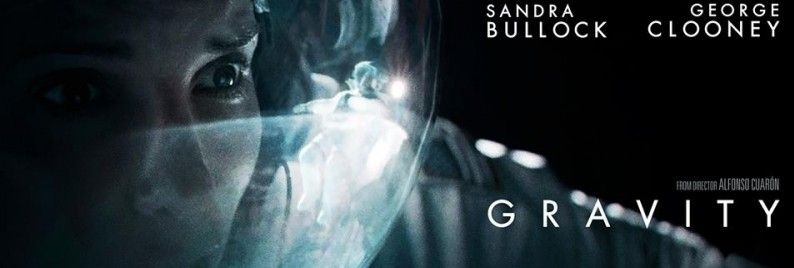
Gravity poster and stills ©2013 Warner Brothers Pictures, all rights reserved.
Space movies are almost always grandiose in their storytelling aspirations. The enormity of space, the raw power of the shuttle, the existential quandary of whether we are alone in a vast Universe, and (as is the case in Gravity) an almost-inevitable crisis that must be resolved to steer the astronauts onboard to safety. There is one critical detail, however, that most fail to convey visually—solitude. Dr. Katherine Coleman, who spent thousands of hours aboard the shuttles Columbia and the International Space Station, and who was a primary mentor to star Sandra Bullock, recounts isolation—spatial separation, physical movements, zero gravity and a distant Earth—as the biggest challenge and reward she faced as an astronaut. With a tense, highly focused storyline centered almost entirely on one brave scientist, Gravity is a virtual space flight for the audience, but also a gripping examination of emotional and physical sequestration. Through this vista, we are able to perceive how beautiful, terrifying and enormous space truly is. Full ScriptPhD.com Gravity review under the “continue reading” cut.
It is in this backdrop that we are first introduced to Mission Specialist Ryan Stone (Bullock), a medical engineer turned novice astronaut sent to repair an arm of the Hubble Telescope, and ebullient, assertive veteran Mission Commander Matt Kowalski (Clooney), out on his last voyage in space. During a routine scanning system installation on the exterior of their shuttle, an intentional demolition of an obsolete satellite sends shrapnel debris unexpectedly hurling through space right in their direction. This nightmare scenario, called the Ablation Cascade, was first hypothesized back in 1978 by NASA scientist Donald J. Kessler. Once the density of objects flying in low Earth orbit became high enough (everything from space junk to satellites to intergalactic matter), a collision between two of those objects would lead to further collisions with other nearby objects, each creating more dangerous debris hurling through space. With catastrophic damage to their shuttle, Kowalski and Ryan are the sole survivors with no access to NASA Mission Control and no ability to steer their shuttle home. Limited oxygen supply and a series of tragic consequences soon leave the two astronauts to survival instincts and a last-ditch escape via an international space station as their only hope for returning to Earth.
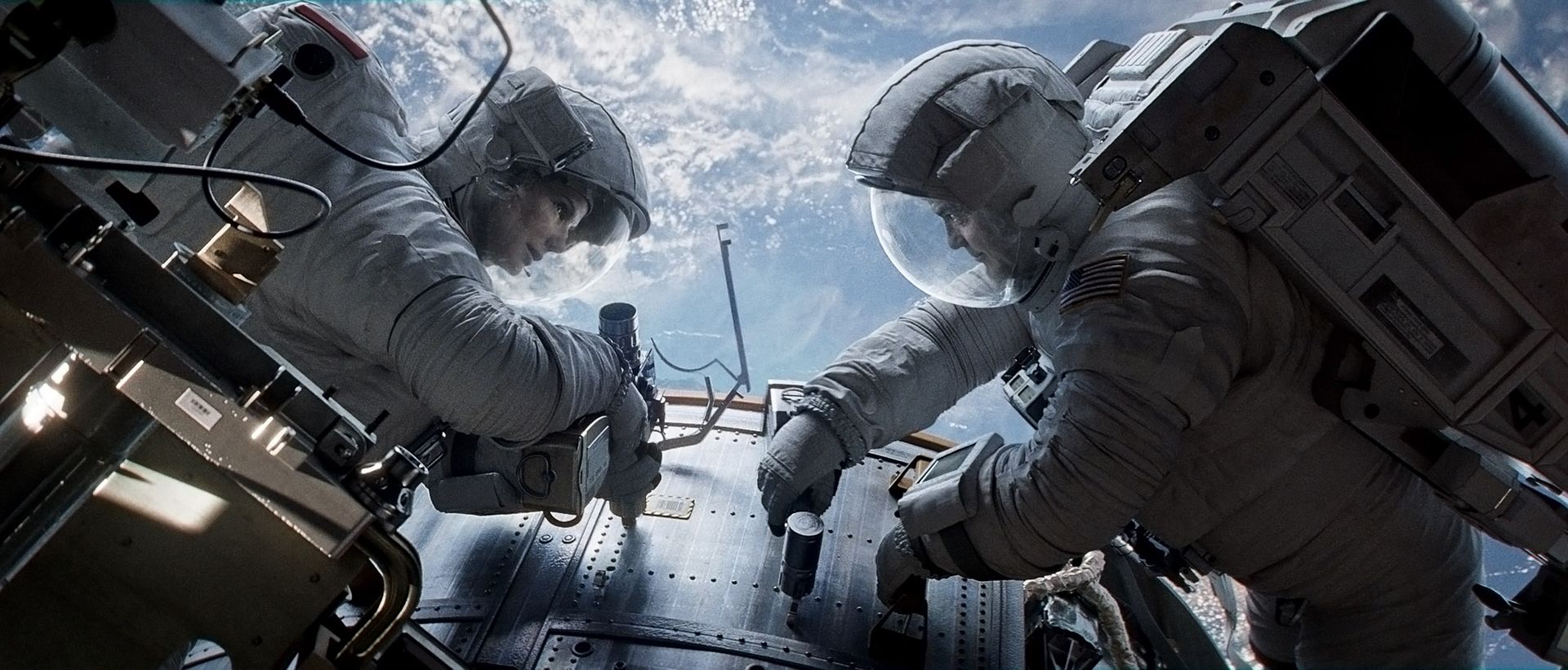
Dr. Ryan Stone (Bullock) and Astronaut Matt Kowalski (Clooney) working on their shuttle before a catastrophic accident moors them alone in space.
Much like its smart 2013 predecessor, Europa Report, Gravity is a highly technical, pinpoint-accurate movie that relied on input from NASA astronauts and physicists for every level of execution. Director Alfonso Cuarón, working on his first big screen film in seven years, worked painstakingly alongside a talented crew to implement previously-unproven digital technologies aimed at transporting audiences into weightless space.
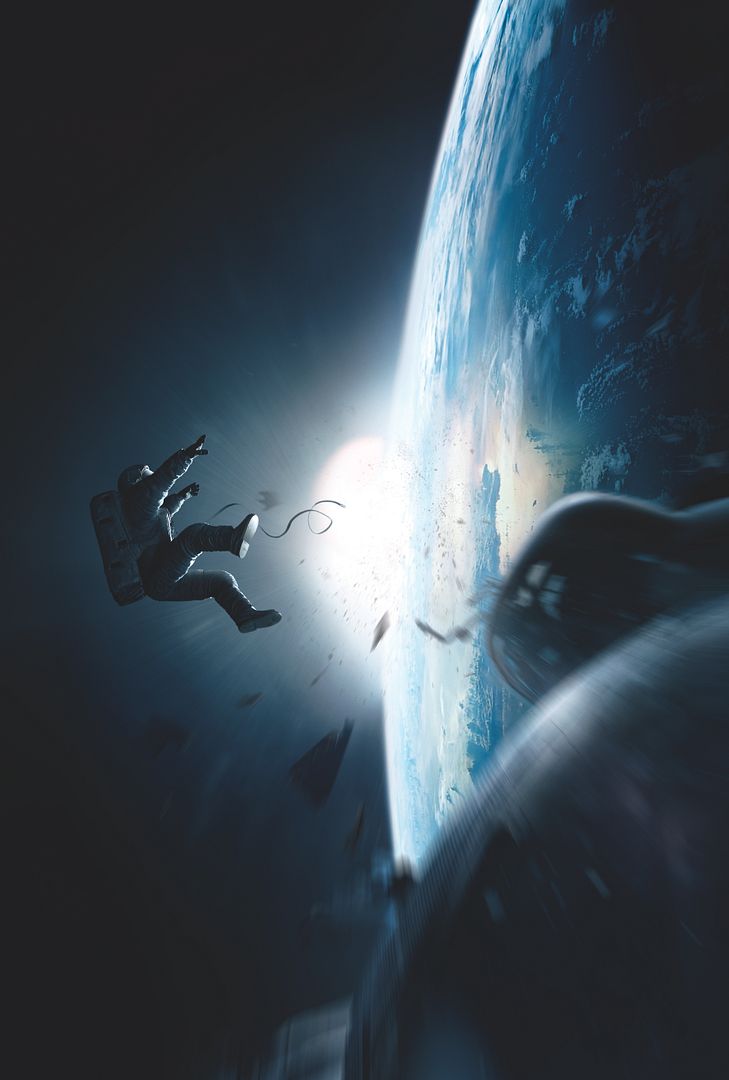
Hold on tight! The jarring view from Dr. Ryan Stone’s (Bullock) helmet of a drifting colleague fighting incoming debris as they both try to stay tethered to their shuttle.
Dr. Michael Massimino, a Hubble service specialist with missions on Space Shuttles Columbia and Atlantis, provided insight into space travel and space walking. In addition, Clooney and Bullock spent hours training for zero gravity conditions, while artistic directors and technical crew built special stage-size light boxes and green screens to be able to create remarkable CGI renderings of space from all angles. “Even if [Gravity] was a work of fiction,” Cuarón remarked at a recent screening preview, “We wanted everything, especially the physics of space, to be as accurate as possible.”
Despite the thrilling story and technical fidelity, there is a stylistic beauty to Gravity rooted in simplicity, a silent abyss in the midst of intergalactic chaos. Cuarón’s desire to showcase space as a central physical and thematic piece of his movie is reflected in every frame. He perceived Gravity to be an existential film about “a woman drifting into the void and confronting adversity.” Rather than being tethered to the constraints of a time and place, however, the solar elements of space are the surge of life that inspires her to keep going.
“I used to think that astronauts wanted to go into space for the thrill and adventure,” Bullock reflected. “When I spoke to them, though, I was so moved by their deep love of that world and the beauty of Earth from their perspective. It’s amazing to realize how small we are in this massive universe.” These are the very details that are magnified on screen as the story unfolds – a tiny human being drifting in the enormity of space, a comforting human voice on the radio amid total abyss, a teardrop defying gravity, the magic of another sunrise viewed from millions of miles away.
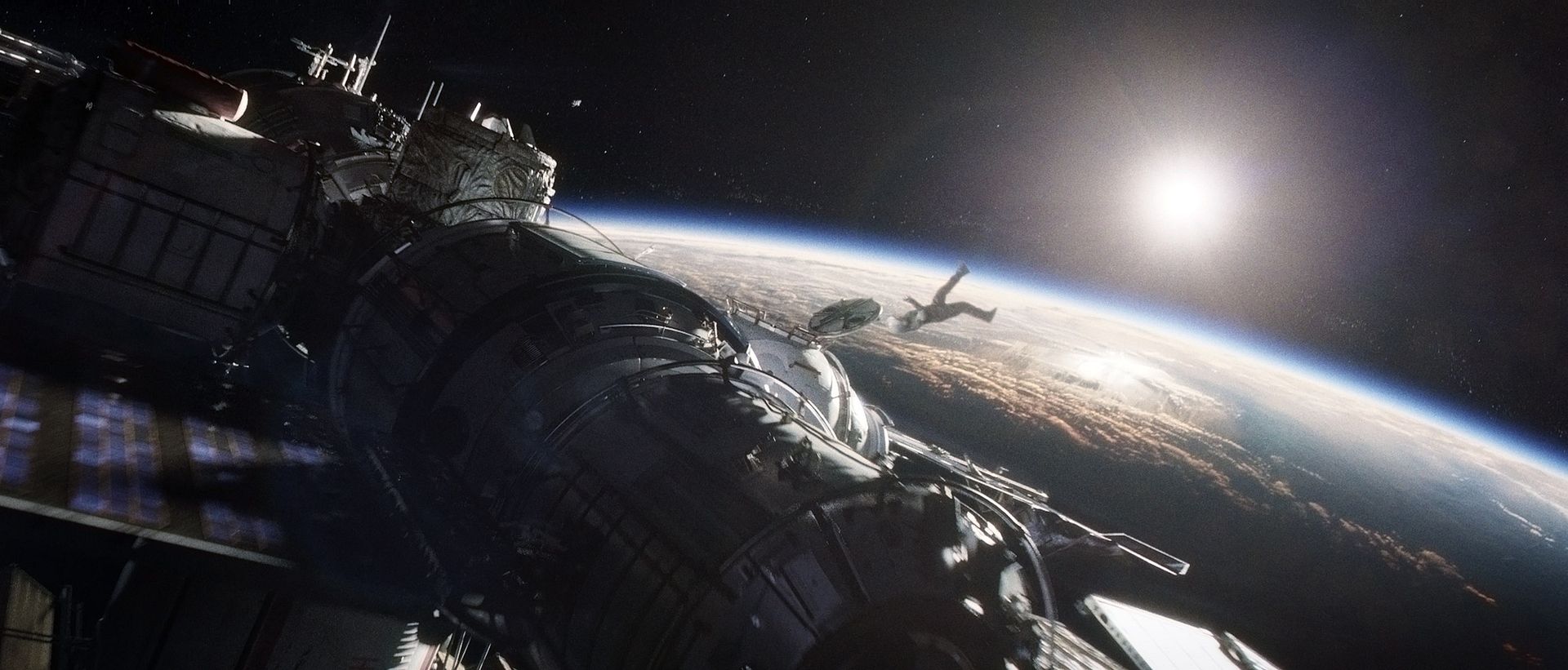
Earth, as viewed from the space shuttle by an astronaut in a scene from “Gravity.”
Far more than just a creative interpretation of space, Gravity is that rare piece of art that can inspire and entertain, a true game-changer in a crowded space film genre. As Dr. Massimino emotionally reminded the press during the preview screening, centers like NASA and the Jet Propulsion Laboratory in Pasadena, CA are still doing important research as part of a space program that is very much thriving and as critical as it has ever been. Gravity is a magical way to bring the masses into space and inspire a new generation of support for NASA. “This movie will make folks understand what we do and why it is so important,” Massimino hopes.
As a love letter to space exploration and the sheer strength of human tenacity, Gravity exceeds all expectations.
Gravity goes into wide release in theaters and IMAX on October 4, 2013.
View an extended Gravity trailer:
~*ScriptPhD*~
*****************
ScriptPhD.com covers science and technology in entertainment, media and advertising. Hire us for creative content development.
Subscribe to free email notifications of new posts on our home page.
]]>
As Comic-Con winds down on the shortened Day 4, we conclude our coverage with two panels that exemplify what Comic-Con is all about. As promised, we dissect the “Comics Design” panel of the world’s top logo designers deconstructing their work, coupled with images of their work. We also bring you an interesting panel of ethnographers, consisting of undergraduate and graduate student, studying the culture and the varying forces that shape Comic-Con. Seriously, they’re studying nerds! Finally, we are delighted to shine our ScriptPhD.com spotlight on new sci-fi author Charles Yu, who presented his new novel at his first (of what we are sure are many) Comic-Con appearance. We sat down and chatted with Charles, and are pleased to publish the interview. And of course, our Day 4 Costume of the Day. Comic-Con 2010 (through the eyes of ScriptPhD.com) ends under the “continue reading” cut!
Comics Design

The visionaries of graphics design for comics (from left to right): Mark Siegel, Chip Kidd, Adam Grano, Mark Chiarello, Keith Wood, and Fawn Lau.
We are not ashamed to admit that here at ScriptPhD.com, we are secret design nerds. We love it, particularly since good design so often elevates the content of films, television, and books, but is a relatively mysterious process. One of THE most fascinating panels that we attended at Comic-Con 2010 was on the design secrets behind some of your favorite comics and book covers. A panel of the world’s leading designers revealed their methodologies (and sometimes failures) in the design process behind their hit pieces, lifting the shroud of secrecy that designers often envelop themselves in. An unparalleled purview into the mind of the designer, and the visual appeal that so often subliminally contributes to the success of a graphic novel, comic, or even regular book. We do, as it turns out, judge books by their covers.
As promised, we revisit this illuminating panel, and thank Christopher Butcher, co-founder of The Toronto Comic Arts Festival and co-owner of The Beguiling, Canada’s finest comics bookstore. Chris was kind enough to provide us with high-quality images of the Comics Design panel’s work, for which we at ScriptPhD.com are grateful. Chris had each of the graphic artists discuss their work with an example of design that worked, and design that didn’t (if available or so inclined). The artist was asked to deconstruct the logo or design and talk about the thought process behind it.
Mark Ciarello – (art + design director at DC Comics)
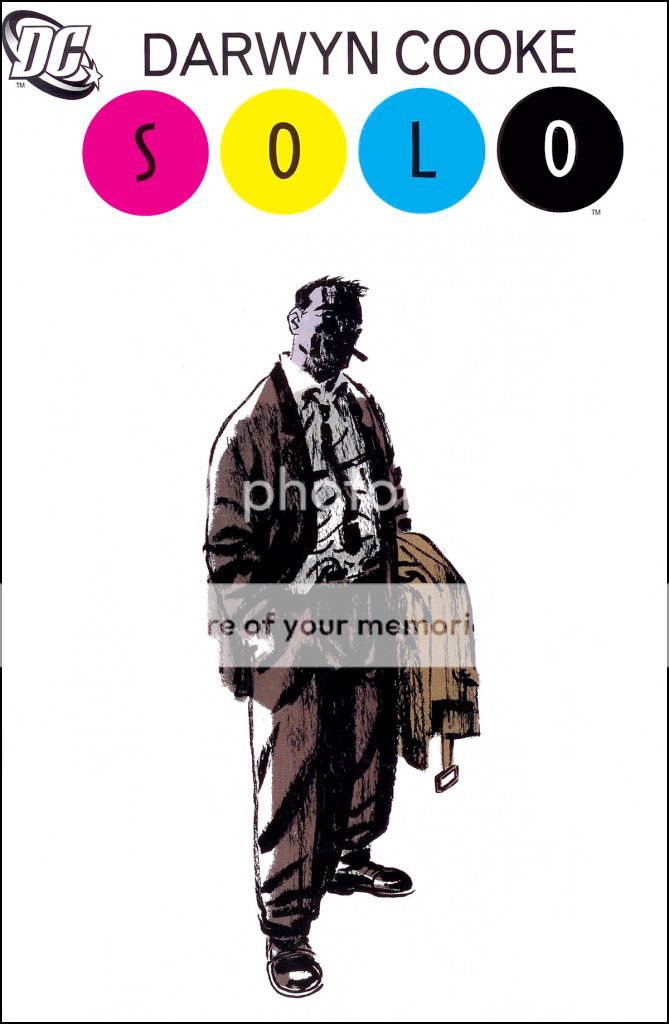
SOLO, a new release from DC Comics.
Mark chose to design the cover of this book with an overall emphasis on the individual artist. Hence the white space on the book, and a focus on the logo above the “solo” artist.
Adam Grano – (designer at Fantagraphics)

The book cover of A Drunken Dream by Moto Hagio
Adam took the title of this book quite literally, and let loose with his design to truly emphasize the title. He called it “method design.” He wanted the cover to look like a drunken dream.
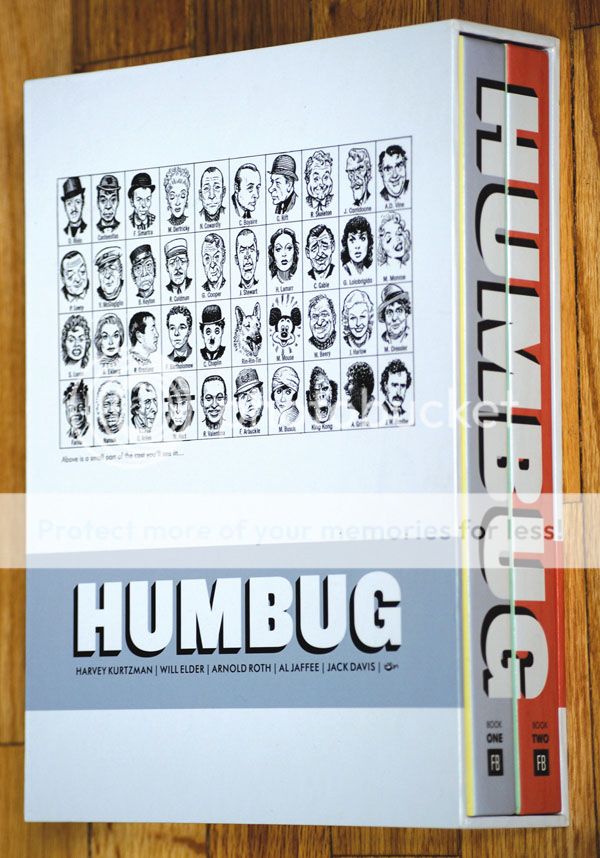
The Humbug collection.
For the Humbug collection, Grano tried hard not to impress too much of himself (and his tastes) in the design of the cover. He wanted to inject simplicity in a project that would stand the test of time, because it was a collector’s series.
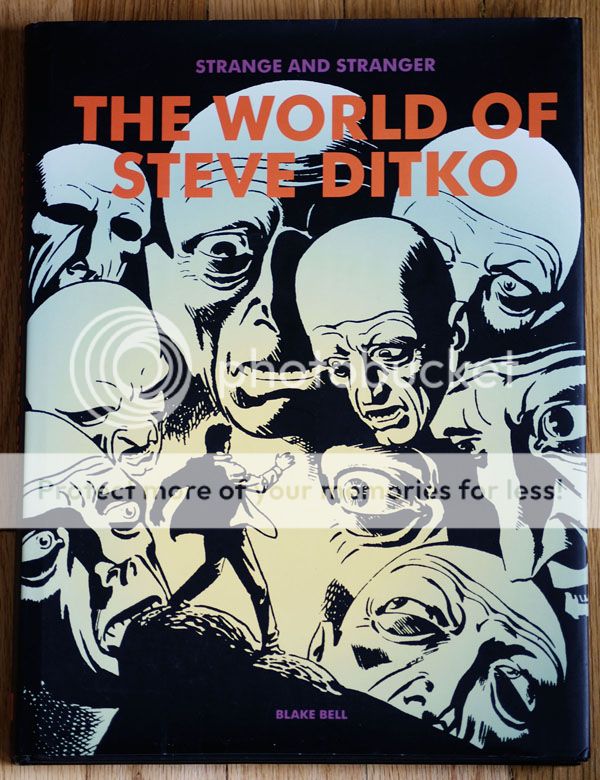
Book cover for The World of Steve Ditko by Blake Bell.
Grano considered this design project his “failure.” It contrasts greatly with the simplicity and elegance of Humbug. He mentioned that everyone on the page is scripted and gridded, something that designers try to avoid in comics.
Chip Kidd – (designer at Random House)
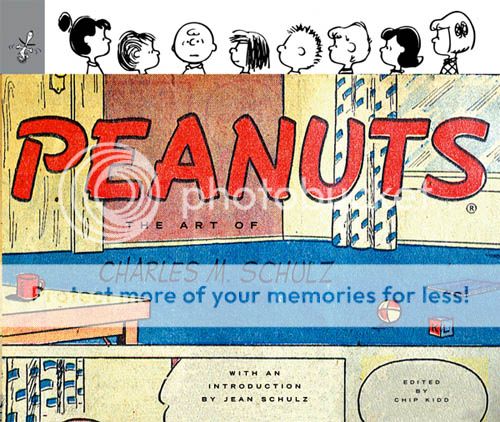
The first Peanuts collection release after Charles M. Schultz's death.
Chip Kidd had the honor of working on the first posthumous Peanuts release after Charles M. Schultz’s death, and took to the project quite seriously. In the cover, he wanted to deconstruct a Peanuts strip. All of the human element is taken out of the strip, with the characters on the cover up to their necks in suburban anxiety.

Grant Morrison's Superman.
Kidd likes this cover because he considers it an updated spin on Superman. It’s not a classic Superman panel, so he designed a logo that deviated from the classic “Superman” logo to match.
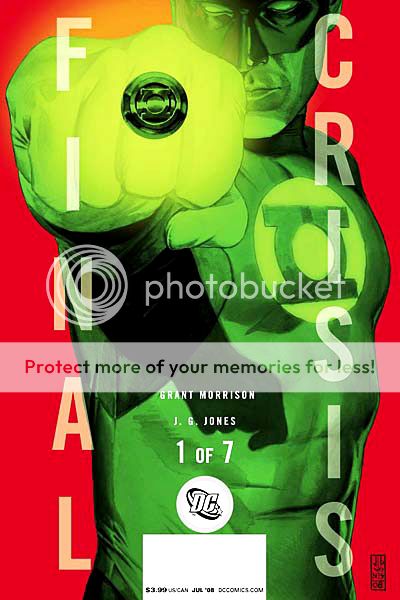
Final Crisis, volume 1, by Grant Morrison and J.G. Jones.
Kidd chose this as his design “failure”, but not the design itself. The cover represents one of seven volumes, in which the logo pictured disintegrates by the seventh issue, to match the crisis in the title. Kidd’s only regret here is that he was too subtle. He wishes he’d chosen to start the logo disintegration progression sooner, as there’s very little difference between the first few volumes.
Fawn Lau – (designer at VIZ)

GenKaku Picasso by Usamaru Furuya
Fawn was commissioned to redesign this book cover for an American audience. Keeping this in mind, and wanting the Japanese animation to be more legible for the American audience, she didn’t want too heavy-handed of a logo. In an utterly genius stroke of creativity, Lau went to an art store, bought $70 worth of art supplies, and played around with them until she constructed the “Picasso” logo. Clever, clever girl!
Mark Siegel – (First Second Books)
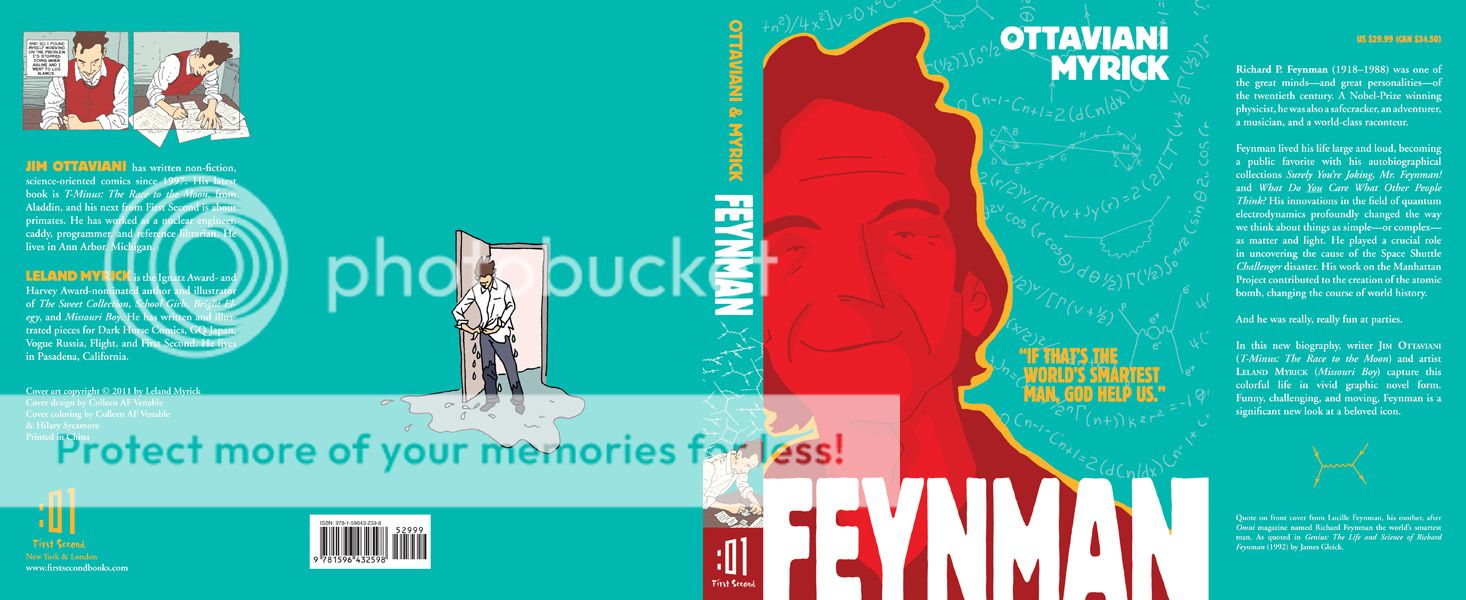
The new biography "Feynman" by Ottaviani Myrick.
Mark Siegel was hired to create the cover of the new biography Feynman, an eponymous title about one of the most famous physicists of all time. Feynman was an amazing man who lived an amazing life, including a Nobel Prize in physics in 1965. His biographer, Ottaviani Myrick, a nuclear physicist and speed skating champion, is an equally accomplished individual. The design of the cover was therefore chosen to reflect their dynamic personalities. The colors were chosen to represent the atomic bomb and Los Alamos, New Mexico, where Feynman assisted in the development of The Manhattan Project. Incidentally, the quote on the cover – “If that’s the world’s smartest man, God help us!” – is from Feynman’s own mother.
Keith Wood – (Oni Press)

The Queen and Country collection.
Wood remarked that this was the first time he was able to do design on a large scale, which really worked for this project. He chose a very basic color scheme, again to emphasize a collection standing the test of time, and designed all the covers simultaneously, including color schemes and graphics. He felt this gave the project a sense of connectedness.

Local by Bryan Wood and Ryan Kelly.
Wood chose a pantone silver as the base of this design with a stenciled typeface meant to look very modern. The back of the cover and the front of the cover were initially going to be reversed when the artists first brought him the renderings. However, Wood felt that since the book’s content is about the idea of a girl’s traveling across the United States, it would be more compelling and evocative to use feet/baggage as the front of the book. He was also the only graphic artist to show a progression of 10-12 renderings, playing with colors, panels and typeface, that led to the final design. He believes in a very traditional approach to design, which includes hand sketches and multiple renderings.
The Culture of Popular Things: Ethnographic Examinations of Comic-Con 2010

Undergraduate and graduate students present their sociology and economics analyses of Comic-Con 2010.
Each year, for the past four years, Comic-Con ends on an academic note. Matthew J. Smith, a professor at Wittenberg University in Ohio, takes along a cadre of students, graduate and undergraduate, to study Comic-Con; the nerds, the geeks, the entertainment component, the comics component, to ultimately understand the culture of what goes on in this fascinating microcosm of consumerism and fandom. By culture, the students embrace the accepted definition by famous anthropologist Raymond J. DeMallie: “what is understood by members of a group.” The students ultimately wanted to ask why people come to Comic-Con in general. They are united by the general forces of being fans; this is what is understood in their group. After milling around the various locales that constituted the Con, the students deduced that two ultimate forces were simultaneously at play. The fan culture drives and energizes the Con as a whole, while strong marketing forces were on display in the exhibit halls and panels.
Maxwell Wassmann, a political economy student at Wayne State University, pointed out that “secretly, what we’re talking about is the culture of buying things.” He compared Comic-Con as a giant shopping mall, a microcosm of our economic system in one place. “If you’ve spent at least 10 minutes at Comic-Con,” he pointed out, “you probably bought something or had something tried to be sold to you. Everything is about marketing.” As a whole, Comic-Con is subliminally designed to reinforce the idea that this piece of pop culture, which ultimately advertises an even greater subset of pop culture, is worth your money. Wassmann pointed out an advertising meme present throughout the weekend that we took notice of as well—garment-challenged ladies advertising the new Green Hornet movie. The movie itself is not terribly sexy, but by using garment-challenged ladies to espouse the very picture of the movie, when you leave Comic-Con and see a poster for Green Hornet, you will subconsciously link it to the sexy images you were exposed to in San Diego, greatly increasing your chances of wanting to see the film. By contrast, Wassmann also pointed out that there is a concomitant old-town economy happening; small comics. In the fringes of the exhibition center and the artists’ space, a totally different microcosm of consumerism and content exchange.

Kane Anderson dressed up in a costume as he immerses himself in the culture of comics fans in San Diego.
Kane Anderson, a PhD student at UC Santa Barbara getting his doctorate in “Superheroology” (seriously, why didn’t I think of that back in graduate school??), came to San Diego to observe how costumes relate to the superhero experience. To fully absorb himself in the experience, and to gain the trust of Con attendees that he’d be interviewing, Anderson came in full costume (see above picture). Overall, he deduced that the costume-goers, who we will openly admit to enjoying and photographing during our stay in San Diego, act as goodwill ambassadors for the characters and superheroes they represent. They also add to the fantasy and adventure of Comic-Con goers, creating the “experience.” The negative side to this is that it evokes a certain “looky-loo” effect, where people are actively seeking out, and singling out, costume-wearers, even though they only constitute 5% of all attendees.
Tanya Zuk, a media masters student from the University of Arizona, and Jacob Sigafoos, an undergraduate communications major at Wittenberg University, both took on the mighty Hollywood forces invading the Con, primarily the distribution of independent content, an enormous portion of the programming at Comic-Con (and a growing presence on the web). Zuk spoke about original video content, more distinctive of new media, is distributed primarily online. It allows for more exchange between creators and their audience than traditional content (such as film and cable television), and builds a community fanbase through organic interaction. Sigafoos expanded on this by talking about how to properly market such material to gain viral popularity—none at all! Lack of marketing, at least traditional forms, is the most successful way to promote a product. Producing a high-quality product, handing it off to friends, and promoting through social media is still the best way to grow a devoted following.
And speaking of Hollywood, their presence at Comic-Con is undeniable. Emily Saidel, a Master’s student at NYU, and Sam Kinney, a business/marketing student at Wittenberg University, both took on the behemoth forces of major studios hawking their products in what originally started out as a quite independent gathering. Saidel tackled Hollywood’s presence at Comic-Con, people’s acceptance/rejection thereof, and how comics are accepted by traditional academic disciplines as didactic tools in and of themselves. The common thread is a clash between the culture and the community. Being a member of a group is a relatively simple idea, but because Comic-Con is so large, it incorporates multiple communities, leading to tensions between those feeling on the outside (i.e. fringe comics or anime fans) versus those feeling on the inside (i.e. the more common mainstream fans). Comics fans would like to be part of that mainstream group and do show interest in those adaptations and changes (we’re all movie buffs, after all), noted Kinney, but feel that Comic-Con is bigger than what it should be.
But how much tension is there between the different subgroups and forces? The most salient example from last year’s Con was the invasion of the uber-mainstream Twilight fans, who not only created a ruckus on the streets of San Diego, but also usurped all the seats of the largest pavilion, Hall H, to wait for their panel, locking out other fans from seeing their panels. (No one was stabbed.) In reality, the supposed clash of cultures is blown out of proportion, with most fans not really feeling the tension. To boot, Seidel pointed out that tension isn’t necessarily a bad thing, either. She gave a metaphor of a rubber band, which only fulfills its purpose with tension. The different forces of Comic-Con work in different ways, if sometimes imperfectly. And that’s a good thing.
Incidentally,
if you are reading this and interested in participating in the week-long program in San Diego next year, visit the official website of the Comic-Con field study for more information. Some of the benefits include: attending the Comic-Con programs of your choice, learning the tools of ethnographic investigation, and presenting the findings as part of a presentation to the Comics Arts Conference. Dr. Matthew Smith, who leads the field study every year, is not just a veteran attendee of Comic-Con, but also the author of The Power of Comics.
COMIC-CON SPOTLIGHT ON: Charles Yu, author of How To Live Safely in a Science Fictional Universe.
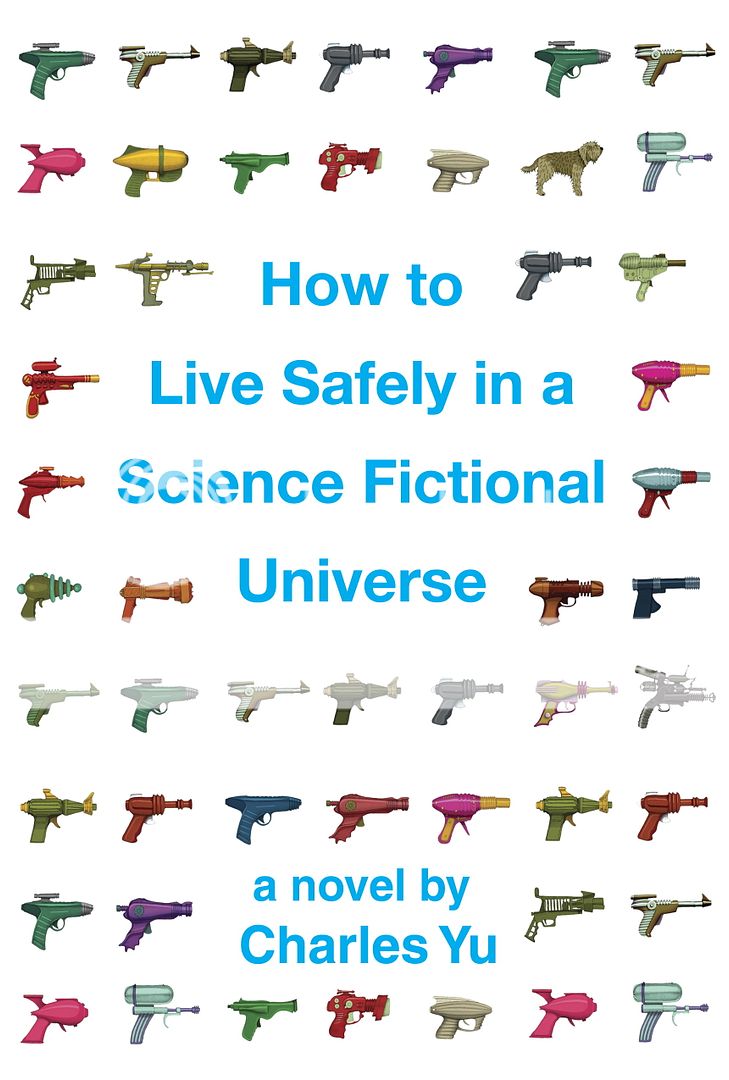
How To Live Safely in a Science Fictional Universe, out in release September 7, 2010.
Here at ScriptPhD.com, we love hobnobbing with the scientific and entertainment elite and talking to writers and filmmakers at the top of their craft as much as the next website. But what we love even more is seeking out new talent, the makers of the books, movies and ideas that you’ll be talking about tomorrow, and being proud to be the first to showcase their work. This year, in our preparation for Comic-Con 2010, we ran across such an individual in Charles Yu, whose first novel, How To Live Safely in a Science Fictional Universe premieres this fall, and who spoke about it at a panel over the weekend. We had an opportunity to have lunch with Charles in Los Angeles just prior Comic-Con, and spoke in-depth about his new book, along with the state of sci-fi in current literature. We’re pretty sure Charles Yu is a name science fiction fans are going to be hearing for some time to come. ScriptPhD.com is proud to shine our 2010 Comic-Con spotlight on Charles and his debut novel, which is available September 7, 2010.
How To Live Safely in a Science Fictional Universe is the story of a son searching for his father… through quantum-space time. The story takes place on Minor Universe 31, a vast story-space on the outskirts of fiction, where paradox fluctuates like the stock market, lonely sexbots beckon failed protagonists, and time travel is serious business. Every day, people get into time machines and try to do the one thing they should never do: try to change the past. That’s where the main character, Charles Yu, time travel technician, steps in. Accompanied by TAMMY (who we consider the new Hal), an operating system with low self-esteem, and a nonexistent but ontologically valid dog named Ed, Charles helps save people from themselves. When he’s not on the job, Charles visits his mother (stuck in a one-hour cycle, she makes dinner over and over and over) and searches for his father, who invented time travel and then vanished.
Questions for Charles Yu

Sci-fi author Charles Yu.
ScriptPhD.com: Charles, the story has tremendous traditional sci-fi roots. Can you discuss where the inspiration for this came from?
Charles Yu: Well the sci-fi angle definitely comes from being a kid in the 80s, when there were blockbuster sci-fi things all over the place. I’ve always loved [that time], as a casual fan, but also wanted to write it. I didn’t even start doing that until after I’d graduated from law school. I did write, growing up, but I never wrote fiction—I didn’t think I’d be any good at it! I wrote poetry in college, minored in it, actually. Fiction and poetry are both incredibly hard, and poetry takes more discipline, but at least when I failed in my early writing, it was a 100 words of failure, instead of 5,000 words of it.
SPhD: What were some of your biggest inspirations growing up (television or books) that contributed to your later work?
CY: Definitely The Foundation Trilogy. I remember reading that in the 8th grade, and I remember spending every waking moment reading, because it was the greatest thing I’d ever read. First of all, I was in the 8th grade, so I hadn’t read that many things, but the idea that Asimov created this entire self-contained universe, it was the first time that I’d been exposed to that idea. And then to have this psychohistory on top, it was kind of trippy. Psychohistory is the idea that social sciences can be just as rigorously captured with equations as any physical science. I think that series of books is the main thing that got me into sci-fi.
SPhD: Any regrets about having named the main character after yourself?
CY: Yes. For a very specific reason. People in my life are going to think it’s biographical, which it’s very much not. And it’s very natural for people to do that. And in my first book of short stories, none of the main characters was named after anyone, and still I had family members that asked if that was about our family, or people that gave me great feedback but then said, “How could you do that to your family?” And it was fiction! I don’t think the book could have gotten written had I not left that placeholder in, because the one thing that drove any sort of emotional connection for the story for me was the idea of having less things to worry about. The other thing is that because the main character is named after you, as you’re writing the book, it acts as a fuel or vector to help drive the emotional completion.
SPhD: In the world of your novel, people live in a lachrymose, technologically-driven society. Any commentary therein whatsoever on the technological numbing of our own current culture?
CY: Yes. But I didn’t mean it as a condemnation, in a sense. I wouldn’t make an overt statement about technology and society, but I am more interested in the way that technology can sometimes not connect people, but enable people’s tendency to isolate themselves. Certainly, technology has amazing connective possibilities, but that would have been a much different story, obviously. The emotional plot-level core of this book is a box. And that sort of drove everything from there. The technology is almost an emotional technology that [Charles, the main character] has invented with his dad. It’s a larger reflection of his inability to move past certain limitations that he’s put on himself.
SPhD: What drives Charles, the main character of this book?
CY: What’s really driving Charles emotionally is looking for his dad. But more than that, is trying to move through time, to navigate the past without getting stuck in it.
SPhD: Both of his companions are non-human. Any significance to that?
CY: It probably speaks more to my limitations as a writer [laughs]. That was all part of the lonely guy type that Charles is being portrayed as. If he had a human with him, he’d be a much different person.
SPhD: The book abounds in scientific jargon and technological terminology, which is par for the course in science fiction, but was still very ambitious. Do you have high expectations of the audience that will read this book?
CY: Yeah. I was just reading an interview where the writer essentially said “You can never go wrong by expecting too much [of your audience].” You can definitely go wrong the other way, because that would come off as terrible, or assuming that you know more. But actually, my concerns were more in the other direction, because I knew I was playing fast and loose with concepts that I know I don’t have a great grasp of. I’m writing from the level of amateur who likes reading science books, and studied science in college—an entertainment layreader. My worry was whether I was BSing too much [of the science]. There are parts where it’s clearly fictional science, but there are other parts that I cite things that are real, and is anyone who reads this who actually knows something about science going to say “What the heck is this guy saying?”
SPhD: How To Live… is written in a very atavistic, retro 80s style of science fiction, and really reminded me of the best of Isaac Asimov. How do you feel about the current state of sci-fi literature as relates to your book?
CY: Two really big keys for me, and things I was thinking about while writing [this book], were one, there is kind of a kitchiness to sci-fi, and I think that’s kind of intentional. It has a kind of do-it-yourself aesthetic to it. In my book, you basically have a guy in the garage with his dad, and yes the dad is an engineer, but it’s in a garage without great equipment, so it’s not going to look sleek, you can imagine what it’s going to look like—it’s going to look like something you’d build with things you have lying around in the garage. On the other hand, it is supposed to be this fully realized time machine, and you’re not supposed to be able to imagine it. Even now, when I’m in the library in the science-fiction section, I’ll often look for anthologies that are from the 80s, or the greatest time travel stories from the 20th Century that cover a much greater range of time than what’s being published now. It’s almost like the advancement of real-world technology is edging closer to what used to be the realm of science fiction. The way that I would think about that is that it’s not exploting what the real possibility of science fiction is, which is to explore a current world or any other completely strange world, but not a world totally envisionable ten years from now. You end up speculating on what’s possible or what’s easily extrapollatable from here; that’s not necessarily going to make for super emotional stories.
Charles Yu is a writer and attorney living in Los Angeles, CA.
Last, but certainly not least, is our final Costume of the Day. We chose this young ninja not only because of the coolness of his costume, but because of his quick wit. As we were taking the snapshot he said, “I’m smiling, you just can’t see it.” And a check mate to you, young sir.

Day 4 Costume of the Day.
Incidentally, you can find much more photographic coverage of Comic-Con on our Facebook fan page. Become a fan, because this week, we will be announcing Comic-Con swag giveaways that only Facebook fans are eligible for.
~*ScriptPhD*~
*****************
ScriptPhD.com covers science and technology in entertainment, media and advertising. Hire our consulting company for creative content development.
Subscribe to free email notifications of new posts on our home page.
]]>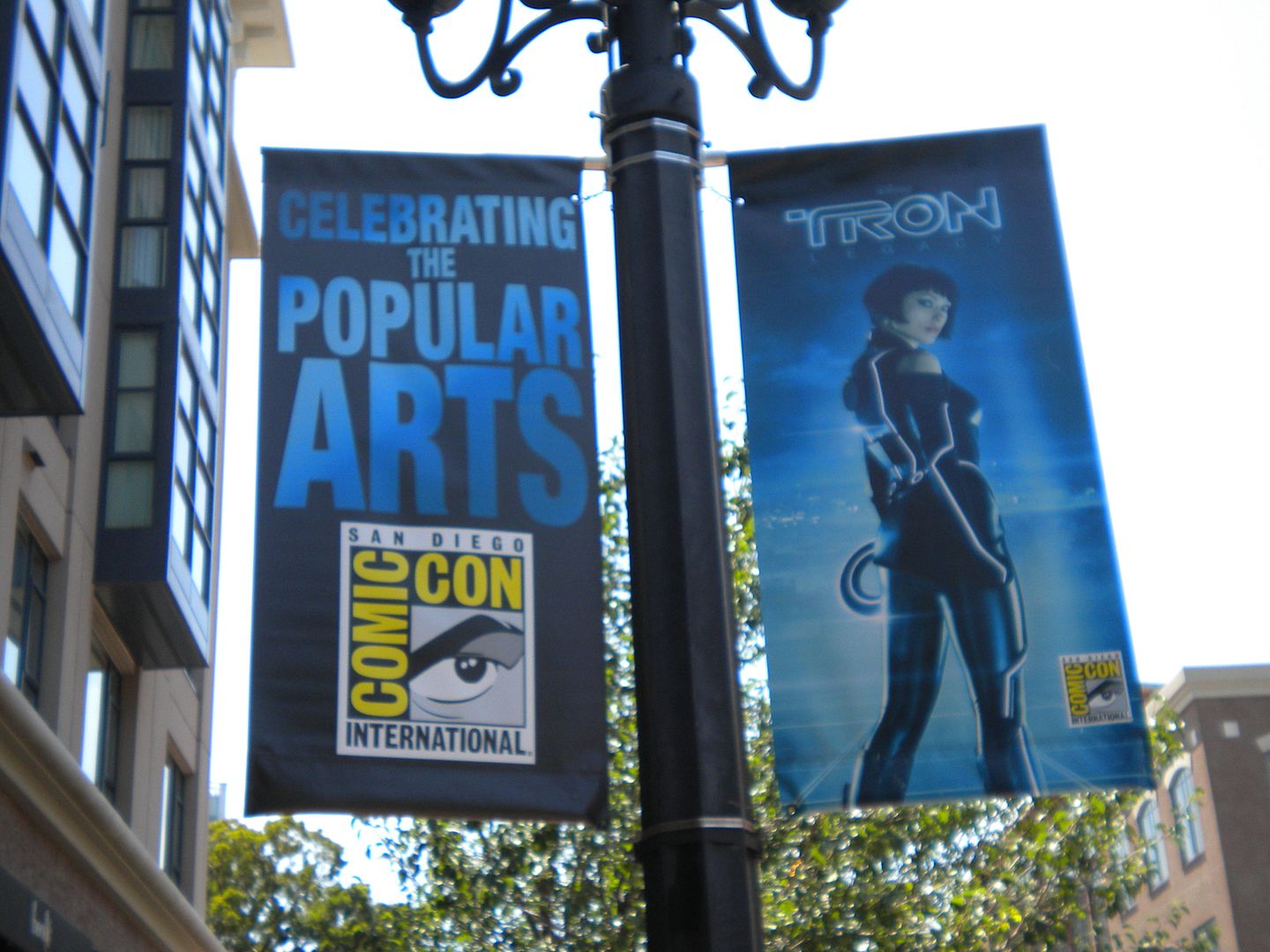
Street signs adorning the City of San Diego for Comic-Con 2010
Day 3 was Star Wars Day at San Diego Comic-Con International and we have something shocking to report, ladies and gentlemen. We did not see a single light saber, not one! Since we almost incurred an unfortunate eye injury last year due to an overenthusiastic Jedi, this was most welcome relief. For ScriptPhD.com, today was all about science and technology. In a day that could not have been more tailor-made for our website, we enjoyed panels with the eminent sci-fi television writers of today discussing writing for genre TV (a must-read for any aspiring TV writers out there!), a visit from the greatest science fiction writer in the history of science fiction, Ray Bradbury, a preview of next season’s sci-fi show The Event, and a panel on how exactly shows like CSI “tech” out with gadgets galore. Oh, yes, did we mention we got to hang out privately with the MythBusters?? With the help of our intrepid reporter Bryy Miller, we bring you the most complete Comic-Con coverage on the web. Plus, our Costume of the Day, after the “continue reading” cut!
The Write Stuff: Creating Genre Television
LOST. CSI. V. Battlestar Galactica. It seems that sci-fi, tech, and geek-chic television is everywhere. Not only is it a staple of prime time (across basic and extended cable), it’s an increasingly popular genre for which good writers are constantly in demand. Since we are SCRIPTPhD.com, an opportunity to listen in as a panel of some of today’s hottest genre television writers gave away secrets of their craft and advice for aspiring writers was irresistible.
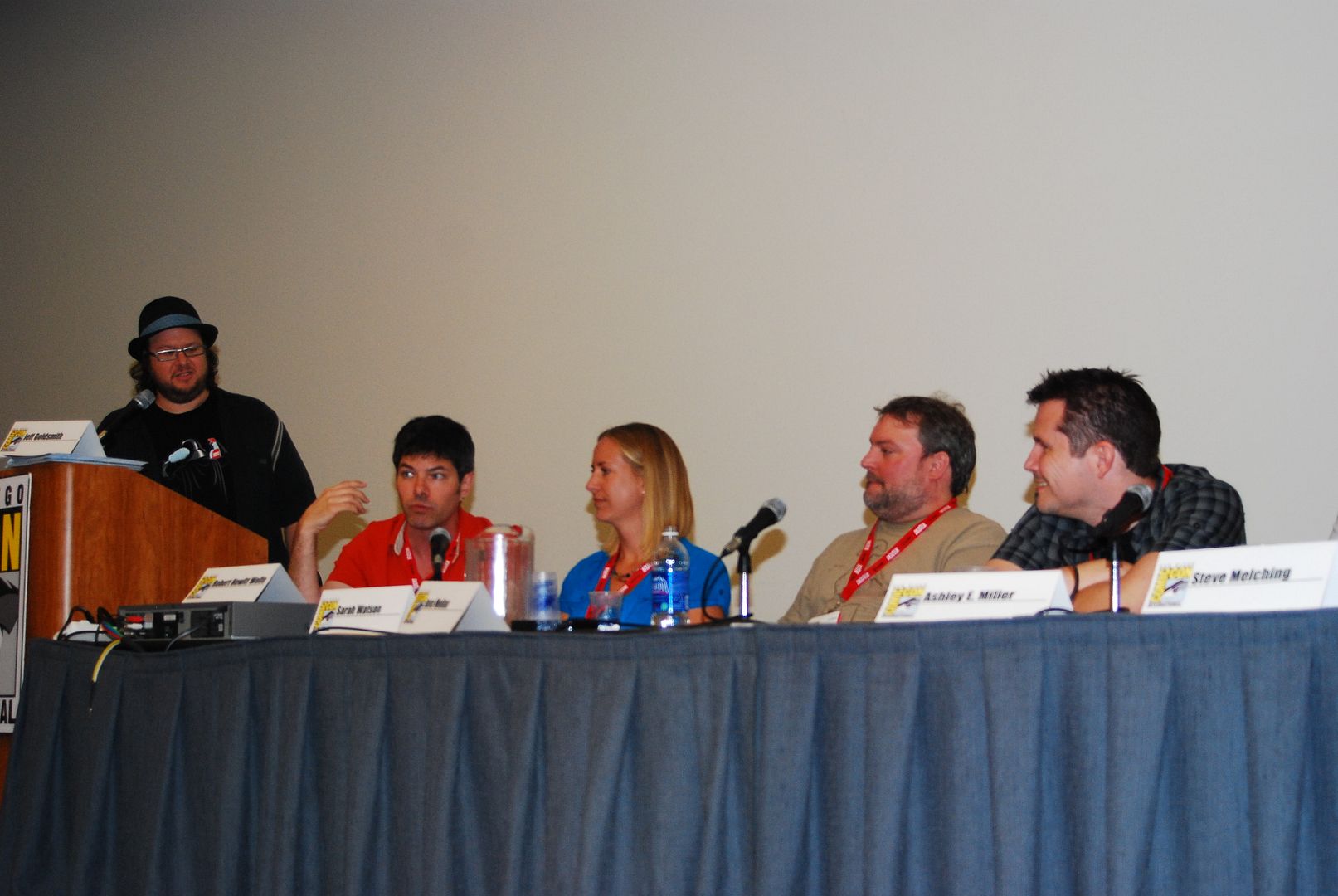
Writing for Genre TV panel Part 1 (from left to right): Moderator Jeff Goldsmith, Javier Grillo-Marxuach, Sarah Watson, Robert Hewitt Wolfe, Ashley E. Miller

Writing for Genre TV Part 2 (from left to right): Steve Melching, Gabrielle Stanton, Jesse Alexander, Steve Kriozere, Charles Murray, and Mark Altman.
Since this panel consisted of so many writers, albeit a dream team thereof, there was only an allotted amount of time for three questions, each of which the panelists answered one by one down the line, and quite enthusiastically. The moderator, Jeff Goldsmith, who runs the industry rag Creative Screenwriting correctly pointed out that not only are they all working in TV, but if they weren’t on this panel, they’d be at Comic-Con anyway. He called them the “Algonquin geek table.” The first question was to ask each screenwriter what brilliant idea they had that would revolutionize a show they were working on at the time, but that couldn’t get past the network censors.
Mark Altman (Castle, Elvis Van Helsing) recalled creating a pilot called Elvis Van Helsing, but ABC went with The Middle Man instead. So he turned it into a graphic novel, and the rest was history. Charles Murray (V, Criminal Minds) actually recalled a terrific idea for an episode of Criminal Minds, where a serial killer would put a milk carton in someone’s fridge and the “Have You Seen This Person?” picture would be of the dead person. Clever, we thought! Steve Kriozere (NCIS, VIP) had the clever idea on VIP of casting Bruce Campbell to play Pamela Anderson’s uncle. The amazing and talented Jesse Alexander (Alias, LOST, Heroes) recalled a victory for geeks in the form of Heroes Season 1 in an episode entitled Days of Future Past where all the characters went into alternate future. He mentioned that it was so hard to approve and get on air, but the episode went on to win multiple awards. What didn’t make it? “Season 5.”
Steve Melching (Clone Wars, Transformers, The Batman) recalled writing for the animated series The Batman taking place in his first few years in Gotham City, and wanted (but failed) to approve a B story about a frat boy group dressing up in D-List costumes, committing fake crimes and then videotaping their subsequent ass kicking by Batman. We wonder why that didn’t get approved. Ashley E. Miller (Fringe, Terminator) wanted a Fringe follow up to the episode “Bishop Revival,” which had an immortal Nazi. He wanted a flashback episode to 1942, where we find out that Agent Phillip Broyles is 100 years old, and whacking Nazis. Jose Molina (Castle, Firefly) wanted a Firefly payoff episode with a 9-months-pregnant woman being evil, where the team kills her but they save the baby, and the episode would consist of three acts of “Three Men and a Baby.” Right. Sarah Watson (Middleman, Parenthood) recalled being hired to do a SyFy Channel movie of the week about an untapped volcano under Manhattan (seriously!), and she had grand plans for lava engulfing Statue of Liberty, taking over all of Manhattan island, but when the movie got produced the visual ended up being lava trickling out from under a garage. Robert Hewitt Wolfe (The Gates, Deep Space Nine) was writing for 4400 in its final season, and was obsessed with the idea of creating an aerosol promycin bomb over Seattle (hmmm, as a Seattleite, I booed this from the audience). The showrunners created a promycin bomb at the end. So the next time you think all TV writers are geniuses, just remember that for every great episode of your favorite show, there were many bad ideas tossed around in the writers’ room.
Next, Goldsmith asked the panel to recount (as diplomatically as possible) the stupidest network notes they’d ever encountered for a show script they worked on.
Mark Altman recalled working on a SyFy Channel movie where executives asked him to recap the whole plot at the beginning of the hour because of people tuning in from HBO. Charles Murray, while working on V, was told he couldn’t use the word lizard in an episode. How do you get past something like that, he was asked. “I left the show. That’s how you get past it.” Steve Kriozere revealed the #1 SyFy Channel rule of movies: don’t speak to the monster. Jesse Alexander, having worked on some of the greatest sci-fi hits ever, waxed more philosophical. Everyone has an opinion on these shows, but executives want the rules of the show’s world, they want everything spelled out clearly, a lot of exposition. They’re generally happier if the shows are procedurals, but sci-fi shows don’t have room for that—if all the secrets and exposition are revealed it drives people away from the content. Steve Melching pointed out that a lot of animated shows have hyper-sensors because they’re aimed at children. The dumbest note he ever received was that you can’t say “killer satellites.” Ashley E. Miller was reminded (we are shocked!) that you cannot have an 11 year old boy say douchenozzle on prime time TV. Jose Molina recalled an episode of Castle where a body is found in the teaser, the guys go through case, and find out that the victim was killed by a stiletto. Said the executives: “Does the killer have to kill with a shoe?” Sarah Watson revealed that the most annoying thing to writers on shows now is that they’re paid by sponsors, so writers have to put products into scenes strategically. Her worst example was an episode of a show with a surf competition…sponsored by Tampax. To make this work, they had to cover a poor actress’s entire surf bodysuit with Tampax logos. Robert Hewitt Wolfe was taken out to dinner by the main executives of a show he was working on and flat out asked to dumb down the series. Ahhh, the things you learn when the iron curtain goes down.
Finally, Goldsmith asked the panel to give advice to young TV writers (or aspiring writers) on how to best write for a budget, which is unfortunately what most young writers will face on television these days.
Without question, the panel answered unanimously that the secret in the writing is all. about. character. The best and cheapest special effects are two actors in a room with terrific conflict and terrific dialogue—that’s what’s compelling, that’s what’s intimate. Most physical action, they reminded us, is actually superfluous—only revert to it after all possible dialogue is tapped out. Ultimately, you must look at how what you cut (if you are forced to cut things) affects the character. If you put six people in a scene, make sure that all of them need to be in the scene, because it is extremely expensive to shoot. The writers lamented that networks sometimes have too much money, and a subsequent desire to compete with Transformers or Iron Man, which television can’t do. Writers must remember that character works for television, and you can have high-concept ideas for sci-fi. That’s why shows on cable, which are often budget-restricted, are so great. Sarah Watson reminded the audience that you can always make a show cheaper, and fantastic, with great writing and great dialogue. This is how Friday Night Lights, which shoots on a shoestring budget down in Texas, was able to survive for five seasons.
Mostly, in advice relevant to any writer reading this, they said not to repeat past mistakes.
The Event

The Event panel (from left to right): Ian Anthony Dale, Zeljko Ivanek, Laura Innes, Sarah Roemer, Jason Ritter, Blair Underwood, and producers Evan Katz, Steve Stark, Jeffrey Reiner, Nick Wauters and Jim Wong.
This television show, premiering in the fall of 2010, might be the new LOST, or it might be the new FlashForward. I’m not sure yet. The Event, a show that is so steeped in mystery that even its title is nothing more than Something Happens, was a show—and will be a show—with as many problems as it has concepts. Fortunately, all of its flaws are structural.
The pilot is laid out as three separate stories (well, actually, four, but one is extremely short in comparison) over the course of three separate acts. We actually start the show in the middle of the story when our hero, Sean Walker (Jason Ritter), hijacks a plane in order to save it, and then flash back to eight days earlier, and then forward to seven days earlier, and then once more to the present. It gets even more confusing when President Eli Martinez (the incredibly suave Blair Underwood) gets his go at the story, and then his segment goes back an entire year. The other two stories comprise of the father of Sean’s girlfriend, whose house and family are assaulted by unknown forces, and Simon Lee (Ian Anthony Dale), the supposed second-in-command of a secret government base/prison that lies at the center of The Event. It’s a shame that Lee’s section is so short, as Dale is a fantastic actor even within the confines of such little material. But perhaps the best acting comes from ER/West Wing (and Northwestern University!) alumna, Laura Innes, who absolutely nails her cryptic sayings as Sofia, the leader of the base/prison/thing-to-be-revealed-later.
The show will need to cut out some of the flashes in order to survive past its initial thirteen episodes, but it is definitely a unique format that works for this type of story. The writing was high-quality and so was the dialogue; there were no qualms there. It also revealed quite a bit about the world that had been set up if you looked closely enough. Co-Producer Evan Katz made the promise that answers would actually come a lot faster than with other mystery longforms. This is welcome, especially since I am of the belief that mystery shows can maintain the mystery if they answer questions in the right or clever way. Sometimes, it is even essential to answer them if you want the show to progress to its next level of weirdness. Blair Underwood was then asked what it is like to be the first Cuban president, to which he replied that there would be no Salsa dancing.
Katz then ended the panel the only way it could have possibly ended:
“The Salsa is not The Event.”
Spotlight On: Ray Bradbury
He is brilliant. He is one of the foremost technology predictors since Leonardo DaVinci. He is irreverent, utterly aware of his importance, and quite simply, the greatest science fiction writer in the history of the genre. He none other than Ray Bradbury. Ray has been coming to Comic-Con since the very first year of its inception. A devoted comics and graphic novel buff, he loves interacting yearly with fans, and gracing them with his musings, knowledge and appreciation. We were honored and somewhat overwhelmed to be there in person for Ray’s 41st Comic-Con panel, on the heels of his 90th birthday. Because Bradbury’s words speak for themselves, we bring you the panel through his eyes.
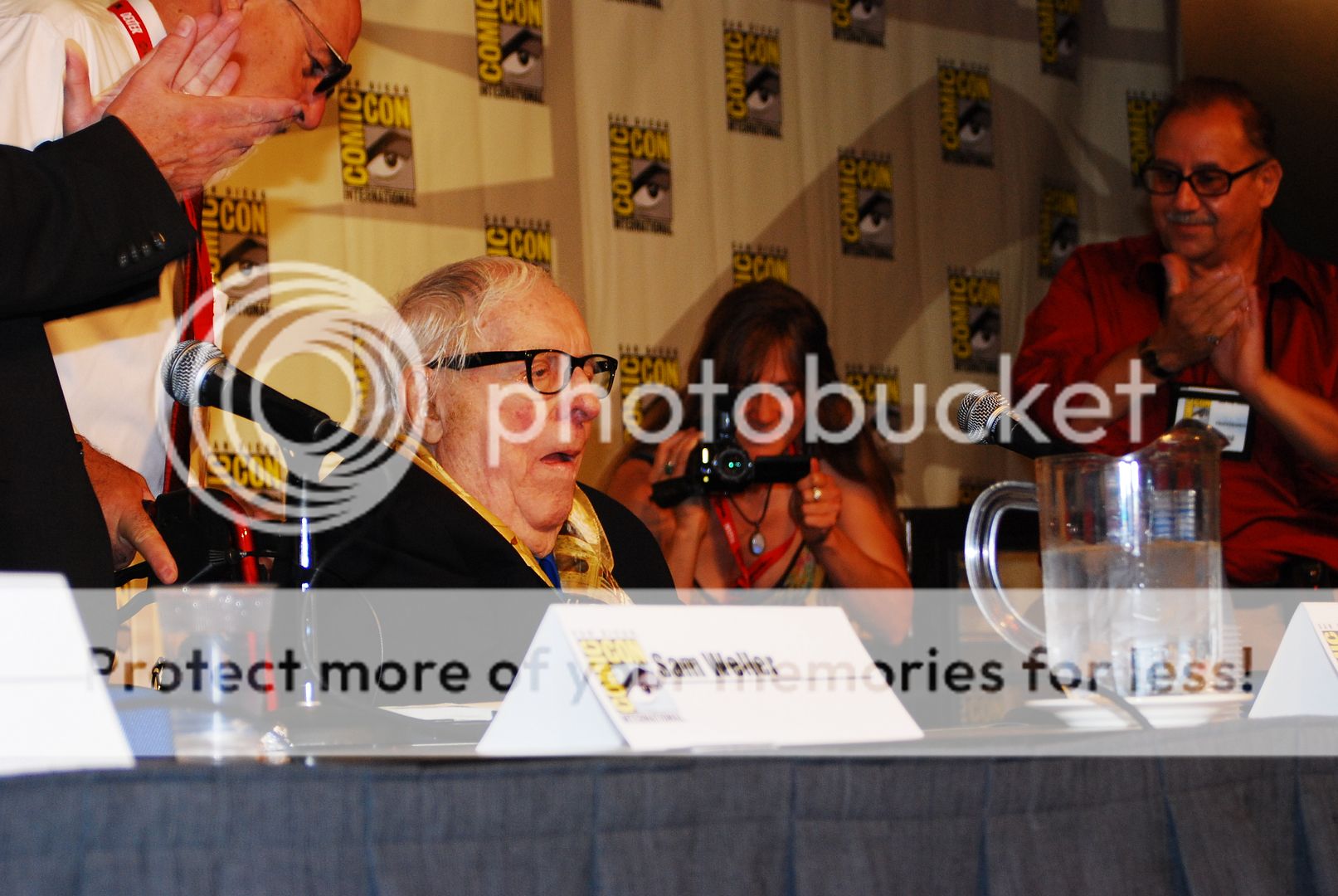
Ray Bradbury being wheeled in for his Comic-Con panel.
Bradbury, not shy about quips and bold statements, starts out his panel with a bang: “I want to make an announcement. Sam Weller and I are working on a new book together: Let’s Let The Cat out of the Bag.” In actuality, Weller and Bradbury released a brand new book of interviews (out June 29th) entitled Listen to the Echoes: The Ray Bradbury Interviews. Weller has spent over a decade with Bradbury, getting to know him, studying his works, and acted as his guide during the panel (Mr. Bradbury has become a bit hard of hearing). Bradbury is currently working on a new book of 20 short stories entitled “Juggernaut” to be published next Christmas.

Sam Weller, middle, Ray Bradbury's biographer, led the panel and discussion at Comic-Con
On how it feels to be Ray Bradbury and if he ever marvels at himself, after a long, thoughtful pause, a hearty laugh and: “It feels mighty damn good.”
Fahrenheit 451 was among the most prescient sci-fi works of all time, predicting technology such as earbuds, flat screen televisions, school violence, and the rise of graphic novels. How did Bradbury predict all this stuff?
“The secret of life is being in love. By being in love, you predict yourself. Whatever you want is what you get. You don’t think about things; just do them. Don’t predict them—just make them.”
Of the technologies Bradbury predicted, he also warned about many, including rise of mass media. What tech would he like to see next?
Again, a thoughtful pause. “I’d like certain technologies to disappear. The internet is a great, big, stupid goddamn bore.” Keep in mind that when Bradbury was approached by an internet magnate to publish his works as e-books for the internet, he responded with: “Prick up your ears and go to hell!” The internet magnate? None other than the CEO of Yahoo.
Another strong, recurring theme of Bradbury’s panel was his love (adoration, really) of space exploration, most notably colonization of Mars and the Moon. Why? “Because we’re going to live forever. We should go back and build a base on the Moon, put a civilization on Mars. 500 years from now, we’ll go out into the Universe, and when we do that, we have a chance to live forever.”
Weller tried to get Bradbury to discuss the new book, once again evoking his crotchety sense of humour: “You can’t afford it. So get out of here and forget it.” In an extremely revealing, intimate moment, Weller pointed out that many Mars stories and works are inspired by and cut from Bradbury’s Martian Chronicles, none more similar than the Twilight Zone. Bradbury then revealed something that many of his fans probably don’t know. “Rod Sterling came to my house many years ago. He didn’t know anything about writing sci-fi. So I took him down to my basement and gave him copies of books written by Roald Dahl, John Collier, a number of other great sci-fi authors, and myself. Rod Sterling forgot that he read all these books, and when he wrote his programs, he copied some of his ideas from me, and we got into a big argument.” The two never reconciled.
As we’ve mentioned, Bradbury came to Comic-Con in its first year, where he said only 300 people came to first meeting, quite different from today, where 1,000 people were gathered in his room alone. Why does he come so often? “Because I’ve been collecting comic strips all my life. I have 30 years’ of Prince Valiant Sunday illustrations put away, all of Buck Rogers. My background in becoming a writer was falling in love with comic strips.” How did they influence his prose and narrative? “Comic strips are full of imagination and glorious adventures. My all-time favorite is Mutts. A year from now, there will be a graphic novel of “The Martian Chronicles” and “Something Wicked This Way Comes.”” Bradbury is, in fact, the world’s greatest (and possibly oldest) fanboy. He is famous for writing fan letters to writers and other figures that he admires. He sent books to John Huston, the famous screenwriter and filmmaker. He sent a hand-written letter to Edgar Rice Burroughs begging him to come to a meeting of Bradbury’s science fiction society club.
Another thing fans may not know is that Bradbury is considered the patron saint of the American library system. He has been very active in rescuing libraries that are under fire because of budgetary crises. He recounted the story of his love affair with the library. “When I left high school, I had no money to go to college. I decided to not worry about going to college. I thought: “I will educate myself.” So I walked down the street, I walked into a library for 3 days a week for 10 years. Most of you in the audience can’t afford to go to college. But if you want to educate yourself, you can afford to go to the library. When I was 28 years old, I graduated from the library.”
The concept of time travel is explored in the short story “A Sound of Thunder.” If Bradbury could time travel, he was asked to what moment it would be? “Every. Single. Moment. Every single moment of my life has been incredible. I’ve savored it. It’s beautiful, because I’ve remained a boy. The man you see here tonight is a 12 year old boy, and he’s having fun!” How does he stay connected to his inner child? “Don’t worry about the future, or the past, you just explode every day. If you’re dynamic, you don’t have to worry about what age you are.”
Indeed, childhood is a theme of many of his short stories. Why is this so important to Bradbury? “Because I grew up loving carnivals and circuses. That’s why I wrote those stories.”
When asked if he had any regrets in life, Bradbury evoked the biggest laugh of the day: “I regret that I didn’t have more time with Bo Derek.” What’s the Bo Derek story? She came up to him in Paris train station, and exclaimed “Mr. Bradbury, I love you!” To which he responded, “Who are you?” She replied, “My name is Bo Derek. Mr. Bradbury, will you travel on the train with me?” With a stoic face he recalled replying: “Yep, I will!” The rest was censored.
Other than Be Derek, what was his greatest love? Bradbury turned philosophical. “I am the world’s greatest lover. I love to write short stories. I write them. I love to write novels. I write them. I love to write poetry. I write it. I love to paint pictures. I paint them. I loved directing a film. So I directed it. Those are my greatest lovers. I have loved all these things I have told you about.”
What authors inspired Bradbury growing up? “Edgar Rice Burrows. And Edgar Allan Poe—scared the hell out of me.”
Another fact about Bradbury that many people may not know is his rather illuminating and successful career as a designer and architect. He was asked how he got involved with designing the San Diego city center Horton Plaza. ”I designed a lot of other places all over LA. 50 years ago, the people who were building the New World’s Fair asked me to redesign the United States Pavilion. I helped build Epcot down in Florida. Because of those works, the people of San Diego came and asked for input in building The Horton Plaza at the center of San Diego.”
Aldous Huxley famously said of Bradbury, “You know what you are sir? You are a poet.” When asked who the poets are that have influenced his writing, Bradbury immediately responded: “Shakespeare and Alexander Pope.”
What are the things that keep Bradbury motivated now? “I have more work to do.”
On how his writing has changed over time: “It’s gotten more brilliant.”
As such a fan of Mars, Bradbury was asked how he feels about the ongoing Martian probes, and the real science evidence they have brought back to Earth. “I’m glad we are doing that [research], but we should be doing more. We should be going there in person. Not with a lander, but with a real rocket ship and landing on Mars.” In a rather endearing moment, Weller revealed that Bradbury has never driven an automobile. But he was invited to the Jet Propulsion Laboratory in Pasadena, where scientists asked him if he’d like to drive the Mars Rover over Mars. So he hasn’t driven on the 405 freeway, but he has driven across Mars! The scientists even gave him a Martian drivers license.
Any futuristic technologies for cities that Bradbury would like to see? “Monorails all over LA and California. Get rid of the goddamn freeways!” As a Los Angeles resident, hear, hear, Mr. Bradbury!
What was the intended audience of Fahrenheit 451 and how does he feel about its rise to prominence as a true modern American classic? “I am not a science fiction writer. All my books are fantasy. But the one book that is pure science fiction is Fahrenheit 451. So I’m glad that I wrote it. I’m glad that you all feel that way about it too.”
Does Bradbury have a favorite work? “All of my books are my favorites. All of my books are my children. I love all my children.”
How does Bradbury feel about digital books? With a cranky grunt: “I’ve already told you that. I don’t like them. I think of iPads and Kindles as books with a computer screen. Real books smell, real books have memories.” We here at ScriptPhD.com would like to give that statement a heartfelt “AMEN!”
Finally, Bradbury, on turning 90 in a few weeks. How does it feel? “It’s been 90 goddamned incredible years!” To which the audience responded by singing him “Happy Birthday.” A surreal, incredible and special moment.
Teching Out on TV

The Teching Out on TV panel (from left to right): Pauley Perrette, Kristen Vangsness, Barrett Foa, and Rich Catalani.
This panel started out with an inundating montage of clips from tech-chic procedurals CSI and NCIS that involved technology of all sorts. It was part awesome and part utterly corny, as words to the song that was spliced in occasionally would find themselves on to the screen. I was afraid that this foreshadowed the panel being just a huge PR stroke for both shows, but I was later proven wrong. Despite the moderator speaking in a loud, fast, incoherent style of mumbling, the rest of the speakers (Anthony Zuicker, creator of CSI; Pauley Perette, CSI; Barrett Foa, NCIS: Los Angeles; Kirsten Vangsness, Criminal Minds; and Rich Catalani, producer of CSI) were very articulate about all aspects of technology on their shows. They strove to make it less a panel about technology on CSI and NCIS and more about technology and how it relates to CSI and NCIS.
The presentation started out with questions about how everyone got involved in their work, and more specifically, how they got involved in technology, or if they even were. Perette studied forensics in college, talking about how, back in her early years, nobody knew a thing about it. She related a story that the first time that her computer was hacked into, she tried to tell the police, but ended up having to explain to them what an IP Address was. Then, after shows such as CSI and Law & Order made technology and forensics mainstream, everyone was a part of a club that they felt they cultivated. “We all became semi-experts,” she said. “It’s been an incredible decade of change. What we’re showing on our show is the grand upmovement”. Vangsness was a tad in the opposite direction: she took teaching jobs in order to support herself, and one of those jobs was teaching PowerPoint to third graders. She now has images of third graders hacking into government installations to post spam of kittens.
Foa stopped the discussion at one point to explain to the audience that his show, unlike the original CSI, does not stare at a green screen when looking at his computer tomfoolery. It is all real. Which complicated matters greatly when Perette’s character met Foa’s in a crossover between their two shows. She had to literally teach him on set how to react to a green screen as oppose to a real image. Foa also related how the super-tech that we often think of as fictional and made up is actually real. The CSI writers have access to China Lake, a military outpost where they test experimental technology. Scary, huh?
But sometimes technology cannot save you, and honest-to-God legwork must be put into use. For one CSI episode involving a stampede of ants, they actually had to hire an Ant Wrangler and clean up all the creepy crawlies using a vacuum. CGI was expected to just look too ridiculous. Then, in a devilish sort of irony, the projector broke, so the panel was cut short and went straight to questions. Perette was met with a young woman who was going to major in Cellular Biology in college because of Perette’s performance on CSI.
Thus, the cycle continues.
MythBusters: Panel + Press Room Coverage
How popular are Discovery Channel’s MythBusters? Very. Each year, the group of geeky demolition rock stars, who prove and disprove popular science myths through the scientific method, represent one of the fan favorite panels at Comic-Con. This year was no different. Press pass notwithstanding, we barely squeezed into a sardine-tight hall full of science fans awaiting their heroes’ arrival. Take a look at the picture below:

A packed-to-the-brim house of 2,000 people awaits the entrance of the MythBusters.
As if the presence of television’s most explosive group wasn’t enough, the audience was tantalized two-fold before the panel. First, a montage video introducing the Busters had us cracking up with its over-the-top… what else?… explosions!

Their entrance was preceded by what else, but a montage of some of their greatest hits!
Then, a special guest, Geoff The Robot from The Late Show with Craig Ferguson, stepped out to proclaim his nerdy love of all things MythBusters.

Geoff, the robot from the Late Show with Craig Ferguson.
Finally, to ear-deafening applause, Chris Hardwick of one of our favorite blogs The Nerdist (follow him on Twitter) introduced the MythBusters, who announced that they’ve signed up for 7 more years of glorious science. This is a very special Comic-Con for them. It’s the first time all five have come as a group, and it is gorgeous geek diva Kari Byron’s first Con.
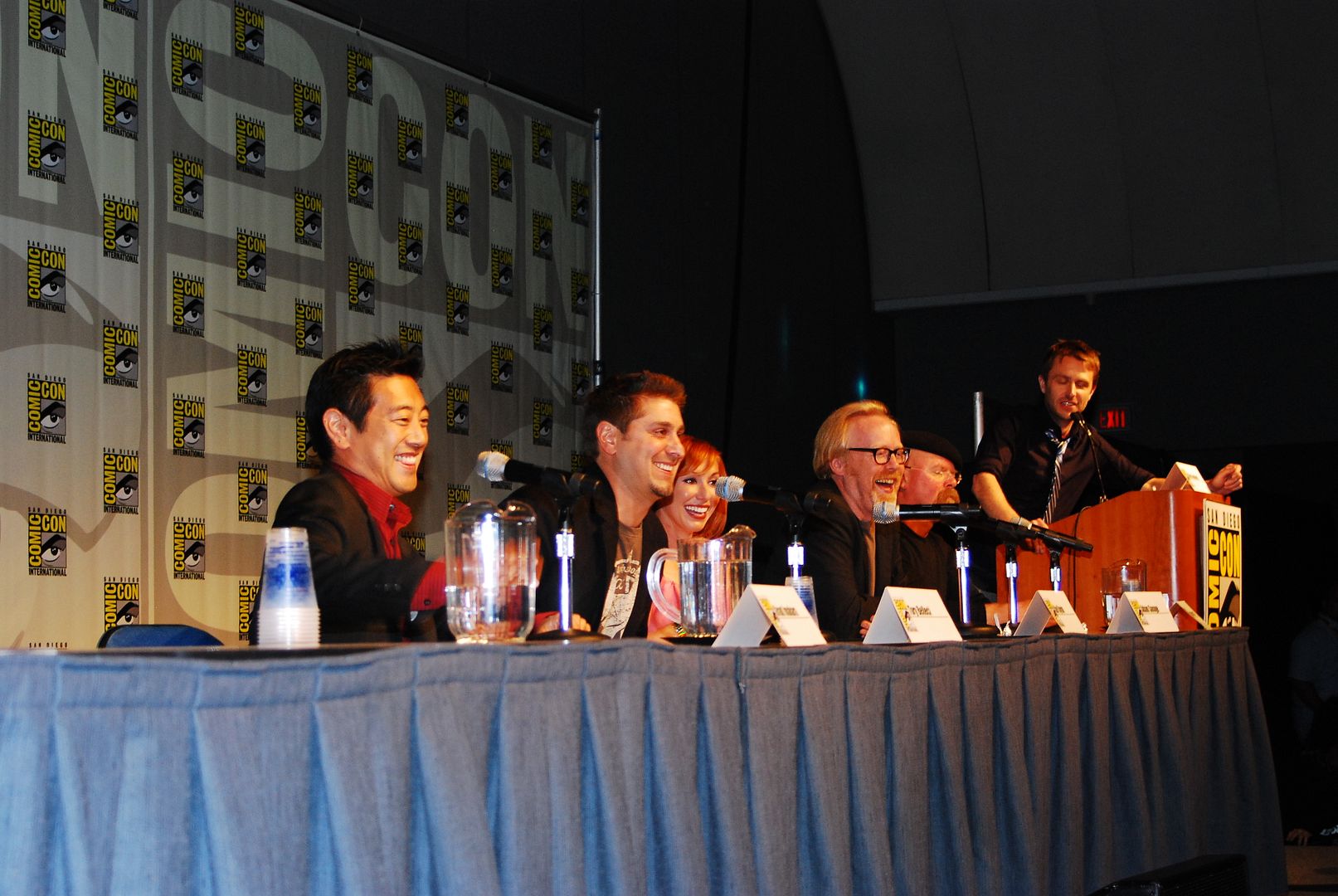
The MythBusters all together at Comic-Con--a first for them! From left to right: Grant Imahara, Tory Belleci, Kari Byron, Adam Savage, Jamie Hyneman, and host Chris Hardwick of The Nerdist.
The first thing the MythBusters wanted their fans to know is just how very real they are. Although they feel like royalty at the Con, when they go back home to San Francisco, MythBusters is far from glamorous. Inside their workshop, which is a workshop and not a studio, they are doing all of the stunts and building themselves. They get dirty, they get bruised, and they do all of the experimenting. Says Adam Savage: “If you see it, we built it.” Although Savage has started getting more involved behind-the-scenes, he explained that the team is so knowledgeable about how to build things, that it’s faster and more efficient for them to do the building than to leave it to someone else. Tory Bellici mused that it would be nice to have stunt doubles sometimes, to which Kari Byron quipped: “They’re not stunts when you fall off.” Did we mention that we love Kari? Jamie Hyneman, who initially signed up for MythBusters because of the allure of getting to try new things, is still having a hard time acknowledging being on TV. When asked what famous people he’d met because of MythBusters, he couldn’t recall one. “President Obama?” nudged Byron. “Oh. Yeah,” replied Hyneman hysterically. Not so for Grant Imahara, possibly the most famous robotics guy in the world. “Craig Ferguson called me the Keith Richards of robotics,” said Grant. “I’m not sure how to take that.”
The audience was treated to a highlight reel of the upcoming season, which promises to have the best, and most extreme, experiments yet. The team revealed some of the secrets. Adam Savage revealed that a scene of a Porsche flipping backwards violently was done to bust an old 1980s myth that classic sports cars are more aerodynamic going backwards than forwards. In an utterly bad-ass bit of reconstruction, the body of a Porsche chassis was cut off, flipped backwards on the car, then raced at 100 miles per hour. Any more questions, kids? A scene showing Kari puking violently (she joked that it was in her contract to have to throw up every year) was explained as an episode testing whether people really do get cold feet when they have to do something scary. For the team, scary meant picking, then eating, two of the most disgusting selections from a table of delicacies consisting of spiders, cockroaches, chicken feet and more. And where does the team get their constant supply of ideas? “Surfing the internet really works!” joked Grant Imahara.
As to whether the team is cognizant of how much they advance science and critical thinking, and actively try to build experiments around didactic aims, the answer is… NO! Jamie remarked that as a whole, the MythBusters are a remarkably curious group. They are curious about stuff, they try to figure it out, and do so in a methodical and logical way. But they never set out to do science. Which, honestly, in the opinion of this website, is why their science is so great.
At this point, the team shared fun and hilarious inside stories from their Comic-Con experience and tidbits from back home in San Francisco. Adam recalls being shocked at two geeks that came up to him at an autograph table with their baby, wearing a onesie that said “Proof that nerds have sex.” Despite his uncomfortable laughter, the duo then asked him to sign their baby! Another fan went up to Jamie and remarked: “I’ve been watching your shows since I was a little girl and now I’m a PhD!” We’re pretty sure Jamie was kidding, but Adam still poked fun back at him. “You’re old!”
Just in time for next week’s Discovery Channel Shark Week, Adam recalled a fan coming up to him a few months back with what the fan was convinced was a brilliant suggestion: “Dude, you know what you should totally do? You should totally prove that, like, punching sharks will make them go away! Seriously, dude, it would be awesome! You’d just punch them.” A brief pause from Adam. “8 months later, there we were, knee deep in sharks, punching them in the face…”
Kari revealed that she filmed the show up to her 10th month of pregnancy. She pointed out that it’s a myth that pregnancy only lasts 9 months. (BUSTED!) She was worried that her baby would never come out. Replied Grant: “With all those explosions and gunshots outside, I wouldn’t come out either!”
Finally, to a fan that asked whether the team is ever scared of an experiment as too dangerous, Jamie reminded him that danger is a relative term. Nothing the MythBusters do is any less dangerous than driving down a freeway at 70 miles an hour. The trick is to good engineering and survive by doing a good job.
The new season of MythBusters premieres in the fall. Find coverage of their Comic-Con panel and clips from the new season on the MythBusters website.

The MythBusters (and Geoff) chilling with us back in the press room after the panel. Aren't they all beyond adorable??
We got to spend even more time hanging out with the MythBusters (and Geoff) backstage in the press area to get even more scoop about the show. We all wondered about the research process that the team undergoes. First and foremost, Adam proclaimed that they “don’t ever get things tested because they’re too dangerous.” There’s nothing the team is afraid of, and no length of time is too long to wait for a payoff. The research can take anywhere from 2 weeks to 2 years. The team searched 19 months for a lead layer thin enough to do an experiment properly. By contrast, the poppy seed drug testing experiment took two hours. They ate poppy seed muffins at 9 AM, and tested positive for heroin at 11 AM (well into the next day).
When asked about their terrific rapport, the team reiterated that they very much enjoy each other’s company and socialize quite well. All of the process, from picking to carrying out experiments, is totally collaborative. Secondly, the team shares a bond because they know each other quite well. “It’s not like we’re a science show boy band,” joked Adam. Most of them have known each other and worked together well before MythBusters began. Unlike other shows, MythBusters goes on for most of the year (46-47 weeks) because the building portions of the segments are so time-consuming. The most important thing to Jamie is a strong sense of respect that trickles down all the way to the show’s loyal crew of 23 people.
For the future of the show, Jamie revealed an interest in looking at the dichotomy of destructive things that do good work as well, steam being high on his list. The team never gets inspiration from movie trailers or clips if there’s no story there and they’re not worthy of a myth.
Adam revealed the interesting fact that somebody actually bought the Corvette which had been fouled by a decomposing pig to prove that a decomposing body can destroy the inside of the car. Adam now associates the smell of cleaner with that episode, which makes him sick to this day. Was that the team’s least favorite experiment, wondered ScriptPhD.com? Grant picked the ear wax candle experiment, jokingly calling it the “seasickness experiment.” Tory picked the chili pepper cure experiment. (“Burns on the way in, burns on the way out!”), while Kari picked the water torture episode. The most destructive experiment to this day, much to the chagrin of OSHA and safety regulation organizations of San Francisco, was the Civil War rocket, tested with a wax core. The team thought they had a proper bunker in the shop, but unfortunately ended up setting fire to their ceiling!
On any potential Discovery Channel crossover shows, Adam revealed that he’d like to go out into the wild with Bear Grylls (and so would I!) while Kari revealed that she would not like to do a dirty job.
And for the highlight of my personal day…

The Nerdist and The ScriptPhD giving a thumbs up to geekdom!
Last, but not least, is our official Day 3 Costume of the Day. We chose this warrior for a simple reason. He braved the chilly convention center without a shirt, yet with a completely covered head. Now if that isn’t upside-down thinking, we don’t know what is!

Our Day 3 Costume of the Day
Incidentally, you can find much more photographic coverage of Comic-Con on our Facebook fan page. Become a fan, because this week, we will be announcing Comic-Con swag giveaways that only Facebook fans are eligible for.
~*ScriptPhD*~
*****************
ScriptPhD.com covers science and technology in entertainment, media and advertising. Hire our consulting company for creative content development.
Subscribe to free email notifications of new posts on our home page.
]]>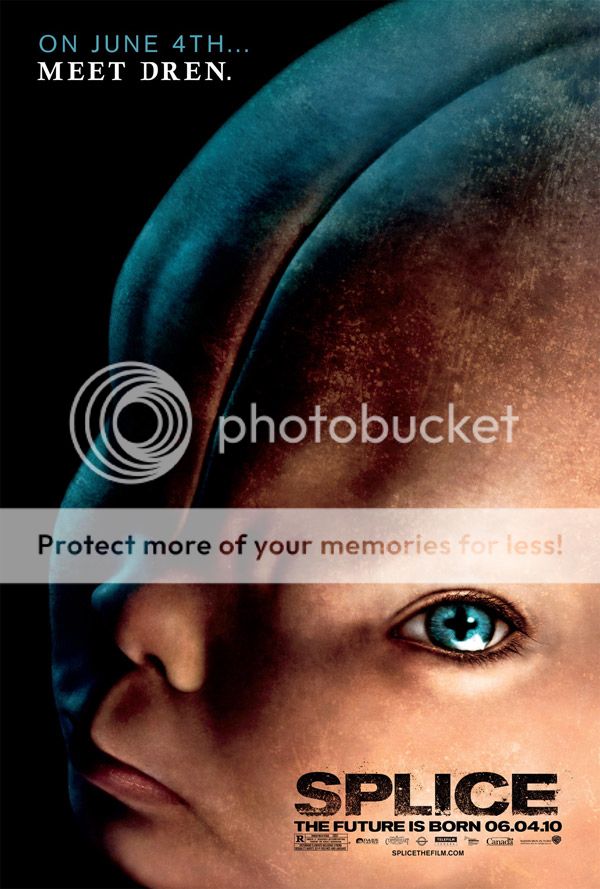
Splice ©2010 Warner Brothers Entertainment, all rights reserved.
About a week and a half ago, scientists achieved a remarkable evolutionary stepping stone in the technological holy grail of eventually engineering synthetic life. Nicknamed ‘Synthia’ by her experimental progenitors, the latest discovery is a viable, self-propagating yeast cell hosting a bacterial Mycoplasma mycoides genome (consisting of non-biological DNA) purely composed in the laboratory. In eerily apt timing, Splice, a new science fiction thriller premiering this week, explores the scientific ramifications and bioethical morass encompassing the creation of a human-animal hybrid by a rogue superstar genetics couple. Under the “continue reading” cut, ScriptPhD.com’s review of Splice, discussion of the expanding frontiers of genetic engineering, and a special video interview with the director/writer, producer and stars of the film.
REVIEW: Splice
ScriptPhD.com Grade: B
Scientists Clive (Adrien Brody) and Elsa (Sarah Polley) are a superstar genetic engineering couple at the peak of their careers. Employed by the shady Newstead Pharmaceutical company, they excel at splicing DNA from various animals to create male-female hybrid breeding pairs, whose blood contains a curative protein to be used for farm animal epidemics. Clive and Elsa’s suggestion of expanding the research to include human-animal hybrids (for the purposes of tackling human disease models) is quickly rejected by the company for moral and ethical reasons. Infuriated by the slight, and buoyed by their burgeoning success, Elsa convinces a skeptical Clive to infuse their hybrids with human DNA (her own) in clandestine experiments. Remarkably, the effort works, and a fetus of unknown composition and sentience begins incubating in their laboratory. Amidst vociferous protests by Clive to “shut down” the experiment, the creature is born and begins aging at a remarkably rapid pace—she will live her whole life in the span of a few months. Nicknamed “Dren” by her creators, the humanoid child quickly forms a parental bond with Clive and Elsa and develops into an intelligent, thinking, feeling woman before their eyes. But even before the duo can formulate a plan for introducing Dren to the world and facing the consequences of their recklessness, an unexpected, awry turn of events with their simpler hybrids (in easily the film’s most noir humor scene) forever changes the course of events for them all.
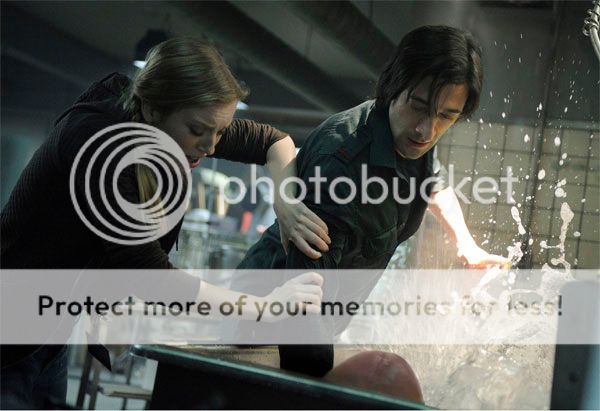
Scientists Clive and Elsa attempt to bathe their genetically engineered creation Dren, in a scene from Splice.
Shot in gorgeous dark hues and with lenses evincing impossible angles, Splice is very much reminiscent of director Vincenzo Natali’s predecessor psychological thriller Cube. The film is also blessed with believable, emotionally rooted acting performances, not the least of which is newcomer Delphine Chanéac’s wordless portrayal of the chimera Dren. Nevertheless, the ambitious material fails to overcome some noticeable flaws. Multiple storylines are introduced without ever being explored beyond the surface. Dren is clearly an intelligent being frustrated by the confines of her helpless existence, but we never learn much more about her than that. Elsa’s motivations for creating (and keeping) her are weighed by a troubled past that is glossed over superfluously. While we at ScriptPhD.com were impressed with the detailed extravagance of the lab sets, and the actors’ ease around the equipment and dialogue, the idea that they alone would have the means and the ability to successfully carry out experiments of this scope in an underground facility borders on the ludicrous. If anything, moviegoers should be relieved that firm regulatory guidelines, not to mention the necessary time and expensive equipment, would render such a scenario unlikely. And then there are, of course, the scenes involving sex between a human and Dren, and both, while shocking, range from the inappropriately funny to the downright disturbing. The director insists that the content was non-negotiable from the start of the film, and that it represented a staple of ancient mythology—to fall in love—that transcends being human. “The prime directive of any organism is to procreate and the creation of a mythical figure like Dren is not too far away,” he said at a recent roundtable gathering in Los Angeles. We’ll let you make up your own minds.

"Synthia" cells containing an artificial DNA genome. Courtesy of Science/AAAS
Ultimately, Splice‘s weaknesses in script and story development are supplanted by its penetrating psychological impact and willingness to take shocking risks in exploring a popular sci-fi staple in a novel way. Regardless of whether you dislike the movie’s artistic choices, or whether it appeals to you on a purely cinematic level, Splice will leave you talking as you leave the theater, and more importantly, will leave you thinking long after having seen it, critical of good science fiction. Especially in a world where scientific possibilities seemingly verge on the limitless, and the technology to realize them develops at a lightning pace, thought-provoking discussion of the resulting profound moral implications will be an important part of science media and entertainment. So what is the likelihood of a “Dren” in our imminent future? Not high. Since the famous Vacanti mouse-human ear chimera done at MIT in 1995 (which partially inspired Splice), development of animal-human hybrids has been sparse. Nevertheless, pigs possessing vasculature flowing with human blood, mice with human brains, and a cornucopia of farm animals with human stem cells have engendered enormous controversy. In 2005, the National Academy of Sciences released a set of voluntary guidelines for researchers working with stem cells, also encompassing chimeras. The International Society for Science and Religion provides an outstanding commentary rich with scholarly science articles on the subject. Furthermore, while British lawmakers approved animal-human hybrids in 2008, a bill introduced by two U.S. Senators in 2009 attempted to prohibit such research (it died in committee, but is surely not the first). Even lead researcher Craig Venter and has acknowledged the considerable time undertaken to create a lone synthetic cell. “We don’t know enough biology to create or synthesize life,” said Boston University synthetic biologist Jim Collins. “I think we’re far removed from understanding how [you would] build a truly artificial genome from scratch.”
Until that fateful day, our imaginations can explore the topic through the kaleidoscope of movies like Splice.
ScriptPhD.com was exceptionally privileged to sit down recently with Splice producer Joel Silver, writer/director Vincenzo Natali, and stars Adrien Brody (Clive) and Sarah Polley (Elsa). We discussed the scientific themes of the film, the ideas of ethics and possibilities in modern genetics pertaining to the film’s content, and how major studio distribution augurs for sci-fi films like Splice.
Official Splice trailer:
Splice releases nationwide on Friday, June 4.
~*ScriptPhD*~
*****************
ScriptPhD.com covers science and technology in entertainment, media and advertising. Hire our consulting company for creative content development.
Follow us on Twitter and our Facebook fan page. Subscribe to free email notifications of new posts on our home page.
]]>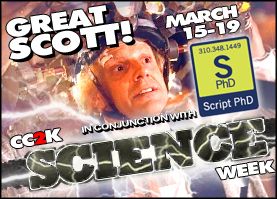
ScriptPhD.com is extraordinarily proud to present our first ever Science Week! Collaborating with the talented writers over at CC2K: The Nexus of Pop Culture and Fandom, we have worked hard to bring you a week’s worth of interviews, reviews, discussion, sci-fi and even science policy. We kick things of in style with a conversation with Professor Malcolm MacIver, a robotics engineer and science consultant on the SyFy Channel hit Caprica. While we have had a number of posts covering Caprica, including a recent interview with executive producer Jane Espenson, to date, no site has interviewed the man that gives her writing team the information they need to bring artificial Cylon intelligence to life. For our exclusive interview, and Dr. MacIver’s thoughts on Cylons, smart robotics, and the challenges of future engineering, please click “continue reading.”
Questions for Professor Malcolm MacIver

Professor Malcolm MacIver. Image courtesy of Northwestern University.
ScriptPhD.com: Your first Hollywood science experience involved consulting for a sequel of the 1980s cult classic Tron. What was it like to dive in from the Northwestern School of Engineering onto a
set and work with screenwriters? What were some of your first impressions?
Malcolm MacIver: It was fascinating to learn a bit about how these huge expensive projects are structured. One specific thing I wanted to know more about was the role of writers in movies versus in TV. I had been told by friends in the industry that writers are typically less prominent players in movies than in top TV shows, were they can have considerable power. Consistent with this, we (the scientists who met with the Tron folks) were not introduced to the writers, who I believe were in the room taking notes, while we were introduced to all the other major players (director, producer, etc). I was also very curious to see how the group of scientists that I was a part of would interact with the movie makers. The culture gap is obviously huge, big enough for massive misunderstandings to blossom during superficially neutral discussions. During our meeting, our approach to the folks involved with the movie varied
from inspired to less admirable attitudes. The less admirable attitudes seemed to arise from the mismatch between the importance scientists can place on their own endeavors, relative to their endeavor’s importance to story telling.
An anecdote I like along those lines is about how the astrophysicist Neil deGrasse Tyson complained to James Cameron that when Kate Winslet looked up from the deck of the Titanic, the stars in the sky were in the wrong position. I liked Cameron’s response, which was “Last I checked the film’s made a billion dollars.” People love the story, not the positions of the stars above the Titanic. We all tend to overemphasize the importance of the thing we are closest to, and it’s a problem that scientists need to be especially attuned to in these contexts.
SPhD: You are now a technical script consultant for Caprica, the television prequel to Battlestar Galactica, providing insight into things like artificial intelligence, robotics and neuroscience. To date, what has been one of your biggest contributions to a final written episode that otherwise wouldn’t have made it in to the storyline?
MM: One of the themes of my research is understanding the ways in which intelligence is not just all about what’s above your shoulders. Nervous systems evolved with the bodies they control—the interaction is extremely sophisticated, and stubbornly resists our attempts to understand it through basic science research or emulation in robotics. Representative of this fact is that we now have a computer that can beat the world chess champion—a paragon of an “above the shoulder” activity—while we are far from being able to robotically emulate the agility of a cockroach.
One of the things we’ve learned about the cleverness that resides outside the cranium is that things like the spinal cord are incredibly sophisticated “brains” operating sometimes without much input from upstairs. Through some old experiments that are better not gone into, scientists showed that animals can walk with little brain beyond the parts that regulate circulation and breathing and their spinal cord. This is because the spinal cord can do most of what we need for basic locomotion without any input. The point is that control of the body is distributed—it doesn’t just live in the brain. The lesson hasn’t been lost on robotics folks; for example, Rodney Brooks popularized an approach called “subsumption architecture” based on this idea. So – back to Caprica: For episode 2, “Rebirth,” the show needed some explanation for why the metacognitive processor was only working in one robot. The real reason, as we know, is that only one had Zoe in it; but the roboticists were being pressed by Daniel Graystone as to why it wasn’t working in others. The idea that I gave them, which they used, was that it was because this particular metacognitive processor had distributed its control to peripheral subunits. Because of this, it had become tied to one particular robot. It’s an idea straight out of contemporary neuroscience and efforts to emulate this in robotics.
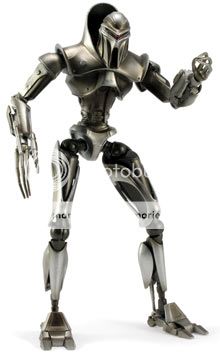
A prototype for the first Cylon, as seen on the television program Caprica. ©NBC Universal, all rights reserved.
SPhD: To me, one of the most fascinating directions of the show is the idea that the first Cylon prototype was born of blood, in this case Zoe Graystone, and because of that, carries sentient emotions and thoughts. What is the fine line between a very smart, capable robot and an actual being?
MM: To vastly oversimplify things, you can imagine a gradation in “being” from a rock to a fully sentient self-aware entity. Some of the differentiators between the rock and you include things like the impact of others on how you think about yourself. For example, categorizing a rock as a particular kind of rock has no effect on the constitution of the rock. This isn’t so for self-aware creatures: once a person is labeled a child abuser, it actually affects the constitution of the person so labeled. People treat child abusers differently from non-child abusers. People who are categorized in this way suddenly see themselves differently; and those who were victims do so as well. The philosopher Ian Hacking, who I studied with during my Masters in Philosophy at the University of Toronto, called this the difference between “Human Kinds” and “Natural Kinds.” Another differentiator is that, for what you refer to as an “actual being,” there is a sense of self-interest in continued survival. Because of this, such a being is susceptible to being harmed, and may also therefore have what an ethicist would call “moral worthiness.” Moral worthiness in turn imposes certain obligations in regard to ethical treatment. For example, returning to the rock, we wouldn’t say we harm a rock when we explode it with dynamite, and we wouldn’t accuse the person who did the blowing up of unethical behavior (certain stripes of environmentalism would differ on this point). Unlike a rock, all animals exhibit an interest in self-preservation.
A very smart and capable robot can be imagined which is not affected by how it is categorized by others, and does not have an interest in self-preservation. So, it would fall short of at least those criteria for full-on “being.” But, there’s a lot more that can be said here, of course.
SPhD: What aspect of the Cylon machine and their story, which is now at the heart of Caprica, do you find the most captivating, either as a viewer or a robotics engineer?
MM: The scenario of our inventions eventually becoming so complex that they begin to have an interest in self preservation, and thus can be harmed (and so may start to be candidates for ethical treatment), is one I’ve thought a lot about in the past. It’s a key theme of the show, too. That’s one aspect that fascinates me about the show. The other is the play between the different kinds of being that Zoe has—from avatar-in-a-robot, to avatar-in-virtual reality, to “really real.” It’s a fun fugue on the varieties of being that raises good questions about the nature of existence and mortality, among others.
SPhD: In your latest post for the Science in Society blog, you explore the theoretical question of whether the United States (or any country, for that matter) could develop a Cylon type of war machine. Do you feel there is a distinct possibility the military might ever pursue this option and how might it impact warfare strategy?
MM: I’m going to explore that in my next few posts—and I’m still formulating my thoughts. In their initial development, a more realistic metaphor for how such robot warriors will work with us is something like a dumbed-down well-trained animal, willing to follow commands but without much of a sense of what to do if something gets in the way, and little recourse to things like flexibly generating new behaviors like a real animal does. But I can’t foresee any significant barriers to the development of autonomous robots with more of the attributes of a fuller kind of being I mentioned to above. I feel the more relevant question is whether this is on the order of 10 years away, or a hundred. Once it happens, the question will then be whether the global community recognizes military applications of this technology as a potential threat in need of careful control, like nuclear arms, or not. That’s all for now – for more you’ll have to visit my blog!

An SR4 smart robot from https://www.SmartRobots.com, currently in use by engineers, designers, developers, project managers, entrepreneurs, students, and businesses. It comes equipped with Linux, wireless web connectivity, and expandability, and costs about $6,400.
SPhD: During last year’s World Science Festival, we covered a really interesting panel called Battlestar Galactica: Cyborgs on the Horizon, which included a cross-section of engineers, ethicists and Battlestar actors discussing artificial intelligence, robotics, and the capabilities of modern engineering, which in some cases are very impressive indeed. In your opinion, what is one of the most significant or promising advance in robotics of the last few years?
MM: The maturing of what is sometimes called “probabilistic robotics.” This approach is what allowed the autonomous car Stanley to win the DARPA Grand Challenge, the challenge to have a vehicle drive itself with no human involvement over a challenging course in the desert. The basic idea is that while traditional robotics was concerned with making precise motions based on very well characterized inputs, what we need for robots to work in the real world is ways to handle the massive array of noisy and uncertain signals that are typically available to guide behavior. There are approaches from probability and statistics for doing this well. These approaches are integral to making robots have greater sensory intelligence. My own laboratory has developed a new kind of sensory robot using this approach, and it works very well.
SPhD: I have previously argued that television and film do more for promoting science by incorporating small, accurate pieces into an overarching story rather than basing an entire story on an unsustainable or far-reaching scientific concept. Thoughts?
MM: TV and film, when it is successful, is about telling a captivating story. The elements of good story telling (emotional connection to the characters, humor, insight into what it is to be human) have little in common with the elements of a good scientific concept (testability, explanatory power, coherence with the rest of what we know). So, yes I’d agree. Trying to do more than incorporate small bits is going to lead to your audience feeling like they are getting a lecture rather having a story shared with them, and no story teller should do that. Documentaries are an interesting hybrid, though—you need a good story, and if it’s about science, a good bit will be on the concepts. How to make that exciting and not spin out into yawn-provoking pedantry is quite the trick.
Malcolm MacIver, PhD, is a professor at Norwestern University with joint appointments in the Biomedical and Mechanical Engineering departments, and an adjunct appointment in the Department of Neurobiology and Physiology. He received a B.Sc. and MA at the University of Toronto, and a PhD in Neuroscience at the University of Illinois in Urbana-Champaign in 2001.
~*ScriptPhD*~
*****************
ScriptPhD.com covers science and technology in entertainment, media and advertising. Hire our consulting company for creative content development.
Follow us on Twitter and our Facebook fan page. Subscribe to free email notifications of new posts on our home page.
]]>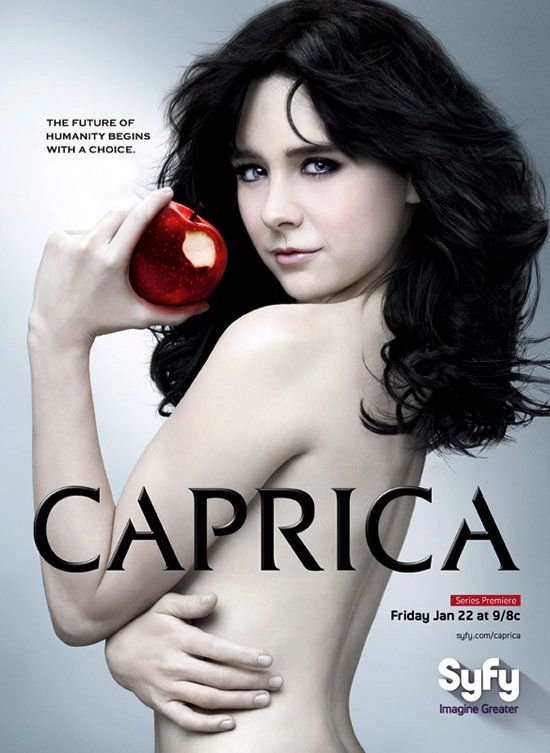
Caprica poster and all images ©2010 NBC Universal, all rights reserved.
No one has been more excited about the premiere of Battlestar Galactica prequel Caprica than ScriptPhd.com. We eagerly joined the cast and crew of both shows last May during their joint panel at the Los Angeles Paley television festival. We were also one of the first sites to review the Caprica 2 hour pilot. And now, at long last, one of the most anticipated sci-fi prequels ever will premiere on the SyFy Channel this Friday. ScriptPhD.com’s Bryy Miller reviews the first three episodes and talks about the show’s early conceptualization and long-term promise. We are also extraordinarily fortunate and proud to bring you an Editor’s interview with series executive producer and show runner Jane Espenson, in which she talks about what we can expect from Caprica. Please click “continue reading” for full content.
REVIEW: Caprica
ScriptPhD.com Grade: B
The spin-off of SyFy ratings spectacular Battlestar Galactica has a lot in common with Shakespeare’s King Lear. Like King Lear, it is far more ambitious than any of Shakespeare’s previous works, both in scope and in depth (yes, even more so than Hamlet—but that’s for another article). In addition, it fleshes out the ensemble on a level far more fluid and psychological than what came before. But, as it turns out, being like King Lear is Caprica’s great flaw. The glitch, so to speak.
Caprica, for the benefit of new fans, is a follow-up to writer/producer Ronald D. Moore’s ambitiously verbose and successful science fiction series, Battlestar Galactica. Caprica’s main mission is to tell the creation story of the being that would one day become mankind’s greatest enemy, an artificial intelligence called the Cylon. Unlike other AI, these robots actually experience emotion and lead “full” lives. This, of course, will make for some rather interesting debates on the nature of intelligence, the soul, and war in general. Caprica takes place approximately 58 years before the events of Galactica, and while my brain is not scientific enough to compute if that is a short enough time span to encompass the full sequence of events, from the looks of it, they seem to be going at a realistic pace. In those 58 years, the Cylons don’t just sit around on the assembly line: they have to gain sentience, be mass produced, become a staple of everyday life, and start the FIRST Cylon war with humanity. Because there is quite a lot of story to tell, the central question is not whether the series is sustainable, but whether the story is worth telling.
Back to the Lear analogy. The thing about BSG was that, even though it possessed quite a large ensemble cast, it was plot-driven. Each character was essential to one overarching story, one goal. Caprica is not plot-driven. It is character-driven, and this is where it becomes a liability to be just like lil’ old King Lear. The writers of Caprica seem content to throw a lot of disparate characters all over the map doing completely different things and interweaving story arcs that feel as if a silk spider had gone to work on them. “It’s more about their personal lives,” admitted series creator/writer Jane Espenson at last year’s Paley event. “They don’t have the threat of death breaking down their neck every moment so that you can feel more lived in, you can explore this culture more.” Added Ronald D. Moore, “It’s a different show. I mean, losing the action-adventure is a risk…. [But] since there’s no Cylons coming in to sort of destroy the Galactica every once in a while, fate and humanity doesn’t hang in the balance yet.” Caprica writers even go as far as to make the main antagonist a polygamist, and give her family life a (sometimes bloated) spotlight. It’s as if they thought simply giving a character something to do would be high drama. Don’t even get me started on the subplot involving what seems to be an entire precinct of corrupt cops, three of which are introduced as part of the ensemble. My fears were not assuaged one bit when I saw that Ron Moore himself was on the writing staff. It may seem contradictory, me saying Ron Moore, the creator of a brilliant generation-defining show, writing for Caprica might be a bad thing. While he does a mean tap dance, Mr. Moore has a tendency to introduce plots into his shows without knowing what they have to do with said show. This is most apparent when he copped to not knowing where a pregnancy storyarc in BSG was going (among a human and Cylon, no less), and when he flat out stated that you don’t know where a season is going to end when you start writing it. This began many debates within the writing community if having a planned story versus on-the-fly writing mattered (the answer is, and always will be, yes). While initial publicity seemed to indicate that his involvement would be minimal, for Caprica’s sake, hopefully it is the Ron Moore of the earlier stages of Battlestar Galactica. It helps that the show is being helmed and written by equally brilliant BSG and Buffy the Vampire Slayer writer Jane Espenson.

Familial adversaries Joe Adama (Esai Morales), Amanda Graystone (Paula Malcolmson) and Daniel Graystone (Eric Stoltz), serve as the ideological dichotomy of the Battlestar prequel.
Our story begins with Daniel Graystone (Eric Stoltz), genius inventor, man about town, owner of seemingly everything. He is Bill Gates 2.0, and unbeknownst to him, his daughter Zoe (Allessandra Torresani), is busy creating artificial life in the form of a digital clone. The very first scene in the series is also the most confusing and frustrating, because it takes place in an Internet 8.0 lab of hers. Picture a fully interactive Second Life, overpopulated with the bored, the rich, and the dumb—which is not fully explained to the viewers in any coherent manner for at least thirty minutes into the two-hour pilot. There is a lot to like about Caprica. Every single concept in Caprica’s world was superb. Amazing. Despite visual and thematic superiority as one would expect from the BSG team, there were problems with early conceptualization. Everything seemed to be told to the viewer three times: once in vague technobabble that is supposed to sound too smart for us, once in a truncated layman’s speak, and yet another in a sort of mystic and supernatural definition. The problem is not with the idea but with its execution. Zoe’s invention—the Amoeba of the Cylons—is basically a search engine that can find genetic data and turn that into… well… memory. RAM. Gigahertz. It’s a fantastic way to explain true AI, the only problem is that the writers do so through the steps outlined before.
Tragedy occurs. Telling would be spoiling, but needless to say, Zoe dies in an accident that not only takes the life of the daughter of Joe Adams (Esai Morales), father of Galactica’s future commander Bill Adama, but also stirs the show’s significant dialogue on monotheism and the Cylons’ embrace of a One True God. Joe will come
into Daniel’s life later, but not before Zoe’s digital avatar says she felt Zoe die. It’s a Christmas Miracle. Daniel discovers this and is torn between being with his daughter once more and exploiting his dead spawn’s technological breakthrough to save his own dying company. Coinciding with Zoe’s death is a ticking clock on a government order for a perfect war machine robot, a hitherto failing experiment. It seems that Zoe 1.0’s death has caused a chain reaction resulting in a steady drop in shares, and the ire of Baxter Sarno (Patton Oswalt), a talk show host that has got to be the love child of Don Draper and Conan O’Brien.
Joe Adama’s story is one of woe from even before the mysterious accident. Adams is a Tauron, an ethnicity most despised out of all the horoscope-based groups of the Caprica/BSG universe. Joe resides as a lawyer in what is a Caprica take on Little Italy in the 1920s. I really loved these scenes, of which there are plenty, and could honestly watch the rest of the series—flaws and all—to its end simply for them. Joe’s brother is in the mob (another mobster looks strikingly similar to one of the 12 human Cylon models, FYI), teaching young Will Adams “street skills” that obviously and ultimately help make him so tough later on; Joe himself is in constant war over being a straight lawyer or being on the payroll. Indeed, at the end of the third episode, he does something so over-the-top that it risks making him seem unbelievable. Coming back to his ties to Graystone, he has a brilliant line about wanting to jump off a bridge that he says to the man during their initial meeting. In fact, both men do tremendous jobs of suffering incomprehensible pain for more than one episode, which I liked. Too many shows blithely brush off important deaths, or death in general. The two men become intertwined, first by loss, then by ideology. Even in conflict, they keep circling each other. But viewers lulled into thinking this is a simple “buddy” arrangement are dead wrong. Sometimes Greystone and Adams like each other, sometimes they don’t, but they always feel like they exist without the other. Graystone lets Adams in on his little “secret”, and their worlds crash into one another like a preordained destiny.
Zoe 2.0, it goes without saying, is the cornerstone of Caprica. No matter what else fails about the show, the ideas and concepts behind Zoe 2.0 shine through. Because Zoe 2.0 was “born” through blood, we get an interesting twist on the idea of violence being inherited; this time, however, it is digital inheritance instead of pure genetics. Because Zoe’s mother, Amanda (Paula Malcolmson), never knew her daughter in life, she has the possibility of getting to know her in death (this never happens in the first three episodes, but it is hinted that they will go down this road in some form). Male tech geeks unwittingly poke and prod at Cylon Zoe 2.0 when daddy downloads her in a prototype robot body, most likely commenting on how we objectify women in our society. Zoe’s “brain”, after being linked to her robot body for a limited time, refuses to work in other bodies, much like an organ being rejected. There’s also a hilarious scene involving Zoe 2.0 in the proto-Cylon shell which will forever be hailed as the ultimate walking-in-on-your-parents moment. Time will tell if these will remain brilliant and worthy science fiction concepts, or if they will be supplanted by other stories as the series evolves.
Overall, one would expect Caprica to have been a bit more polished, especially coming from the purebred creative stock that it is derived from, but it’s a pretty decent start to a prologue. Regardless of the flaws in the writing and story structure, Caprica has enough going for it to be at least a casual watch with a cult following from the previous series. It won’t be as good as people say, but it won’t be as bad as they say, either. Which is enough like King Lear as you can get, acclaim-wise.
Caprica airs on the SyFy Channel, Fridays at 9pm, premiering January 22, 2010
The cast and crew of Caprica preview what to expect in the show, and their world:
Interview with Battlestar Galactica writer and Caprica showrunner Jane Espenson:
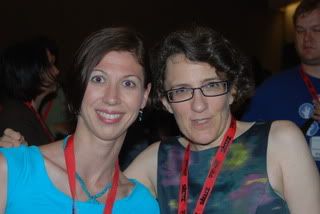
Jane Espenson dished with the ScriptPhD at Comic-Con 2009. We can't wait to see her this year!
ScriptPhD.com was extraordinarily grateful to the SyFy Channel and Jane Espenson for granting us the opportunity to ask a few preview questions. We wanted to ensure ScriptPhD fans’ questions got answered and that we could bring you exclusive scoop that you can’t find on any other site. Here is what Jane had to say about the show, her career, and a look back at BSG:
ScriptPhD.com: A lot of fans know you from your brilliant work on Buffy the Vampire Slayer, The Gilmore Girls, and most recently Battlestar Galactica. But what a lot of fans don’t know is that you had a most atypical entry point into the Hollywood scene. You studied linguistics at UC Berkeley, both as an undergraduate and a graduate student, with some very impressive academic achievements before getting noticed for your Star Trek: The Next Generation spec script. How do you feel that the rigors of academic study prepared you for Hollywood, writing for TV, and now, being a showrunner?
Jane Espenson: Wow, interesting question — I have no idea if it’s going to lead to an interesting answer, but let’s give it a try! My graduate work was in a very specific part of Linguistics/Cognitive Science — I studied metaphor, not as a literary device, but as an important part of how we conceptualize the world around us. In a way I suppose it’s a very science fictiony area of study because it’s all about the ways our brains translate our abstract interactions with the world into OTHER kinds of interactions with the world. There’s something very “V-world” going on even inside our own brains, to use some of the parlance of Caprica. The climate of inquiry and open-mindedness that I encountered in school is very much like what you find in the writers’ room of a science fiction television show. And, of course, science fiction is inherently about metaphor — understanding our world by filtering it through a different set of rules. There are days in which what I did in school feels very separate from what I do now, and days in which it feels like I never left — like it’s all part of the same inquiry. But now I get to write for robots!
SPhD: This is a Battlestar Galactica: The Plan question from our fan Grey. He brought up the interesting point that the Cylon John Cavil has one of the most fascinating, perplexing roles in this movie (and arguably the Galactica story). His character seems to contradict himself philosophically and morally a lot. Just as the Cavil on Caprica learns to trust from Anders and the Resistance, the Cavil on Galactica seems to learn not to trust from Ellen and the other Cylons. Indeed, the Caprica Cavil has a point blank shot at Starbuck and he doesn’t kill her, but viciously knifes the little boy that befriended him on the Galactica ship. Do you have any thoughts on this?
JE: Yes, exactly — the two Cavils go on different journeys that lead them to diverge. The Cavil on Caprica learns a lesson that the Cavil in the fleet doesn’t learn. Caprica-Cavil learns that the love for humanity is going to survive even if humans themselves don’t. He doesn’t take the shot at Kara and he comes to view the entire attempted genocide as a massive error. Fleet-Cavil has other experiences in which the Cylons who surround him are repeatedly rendered useless by the affect humans have on them. When even he starts to feel the appeal of humanity, he lashes out at the orphan boy. He steels himself against humanity and his views become more and more unforgiving. By the end of The Plan, the two Cavils have very different opinions on the actions they’ve already taken, and what they should do next. Events of the end of the BSG series tell use which position was adopted by the other Cavils. (It wasn’t the more loving one.)
A Caprica question from another fan, Iqbal. He wonders if the show Caprica will explore moral ambiguity not just in surface concepts, but really try hard to pull topics from our own contemporary struggles (two wars, religious conflict, health care, the failure to engender proper economic reform, etc) in ways that defy the superficiality of the mainstream media as well as explore historic issues — as some of your best collective work on BSG did?
JE: We made a real attempt to make sure we were writing episodes, not essays. But, yes, absolutely, matters of religious conflict, abuse of government power and cultural bias are so thoroughly cooked into our show that the episodes inevitably explore these issues. And moral ambiguity is really the key to the show. The characters on our show tend to believe that their personal values are the key to keeping their world from sliding to its destruction, so they’re all driven by highly moral principals from their point of view, which may not be at all the view of the other characters or of the viewers. This was really exciting stuff to write. So yes, we do address contemporary issues, but we don’t bend the show around to focus its lens on the issues — we let it occur naturally as the stories take us there.
SPhD: A really fun Caprica question from our fan Josh! In the Caprica pilot, we saw the END of a professional pyramid C-Bucs game where they left the court….is it possible the writers might incorporate an actual Pyramid game for us to see on Caprica?
JE: Yes! We will see parts of games. It turns out that large arenas, and more importantly, large crowds are very expensive to film, but you will definitely see and hear some game play. Both the team and Atlas Arena itself will be very important to our story as it unfolds.
Film director and screenwriter Bryy Miller is the president of Lefty Films.
~*Yorick Archer*~
******************
ScriptPhD.com covers science and technology in entertainment, media and advertising. Hire our consulting company for creative content development.
Subscribe to free email notifications of new posts on our home page.
]]>Avatar poster and all images ©2009 20th Century Fox. All rights reserved.
There are certain films that outlive their theatrical releases to become evolutionary stepping stones of filmmaking. Long after the popcorn has been munched and the Oscars handed out, these movies stand the test of time and usher in the cinematic equivalents of geologic Eras. D.W. Griffith’s The Birth of a Nation redefined the beauty of silent imagery. Alan Crosland’s The Jazz Singer integrated sound and heralded the rise of “the talkie.” Orson Welles’s Citizen Kane became a hallmark of big-budget studio genius. And every sci-fi film of the last forty years owes debt to the standard set by Stanley Kubrick’s 2001: A Space Odyssey. And then there is Avatar. That this film, with fifteen years of creative development, four years of full-time work, and endless hype, was bound to be good seems like manifest destiny. But it doesn’t just live up to its hype—it exceeds it. James Cameron has reinvented visual possibilities, perfected multi-layered storytelling and provided a service to audiences and filmmakers. He has transitioned us into the next big cinematic Era: 3D. Avatar is a ScriptPhD.com Editor’s Selection. For a full review, please click “continue reading”.
REVIEW: Avatar
ScriptPhD.com Grade: A+ (Editor’s Selection)
The year is 2154. The Earth has long been pillaged of its resources and habitability. Looking to solve this impending energy crisis, a human colony has been mining for the valuable mineral ‘unobtanium’ for three decades on Pandora, a distant Moon of the Alpha Centauri-A star system. At 4.4 billion light years away, travel to Pandora requires six years of arduous travel in cryogenic hibernation. Although possessing an Earth-like environment, Pandora’s atmosphere is toxic. Furthermore, native denizens, a humanoid Na’avi tribe, present a direct threat to humans, due both to their advanced biomechanical structure and animosity towards their occupiers’ fixations on what they feel is their sacred native land. In order to explore the territory safely, human being “drivers” must virtually connect their consciousness to a physical avatar hybrid composed of 50% human DNA and 50% Na’avi DNA. Referred to pejoratively by the Na’avi as “the sky people,” human imperialists become increasingly aggressive about destroying native territory to harvest ‘unobtainium,’ leading to perilous tensions between the two groups and the brink of all-out war.
Neytiri teaches Jake how to shoot a bow and arrow, in a scene from Avatar. ©2009 20th Century Fox, all rights reserved.
Enter Jake Sully (Sam Worthington), an accidental everyman hero and paraplegic ex-Marine. No doubt an ode to Cameron’s own brother John David, who served in the first Gulf War and even helped train Worthington for the role, Sully is lacking in mobility but still a warrior at heart. After the death of his twin brother, a scientist at the Avatar Program, Sully is the only one whose DNA matches and can drive his brother’s Na’avi avatar. Overly eager to use his new virtual body, Jake gets trapped on Pandora and saved by the beautiful Princess Neytari (Zoë Saldana). Far from viewing him favorably, she can’t ignore an auspicious sign from the Na’avi deity Eywah that Jake must become one of them and learn their ways. This is music to the ears of chain-smoking tough-as-nails head scientist Dr. Grace Augustine (Sigourney Weaver, flawless), who sees this as an opportunity to study the Na’avi in an unprecedented way. Colonel Miles Quatrich, a despotic Rambo played with jingoistic abandon by Stephen Lang, recruits Sully as special ops to learn the Na’avi weaknesses and where they may be infiltrated. Mediating the two camps is Resources Development Administration agent Parker Selfridge (Giovanni Ribisi), an insipid corporate monger who will work with whichever side leads to the ‘unobtainium.’ The scientists’ interests are purely the biology of Pandora and forging diplomacy with its peoples, the military to wield might (shock and awe, anyone?), and the RDA to make as much money as possible. Jake is caught between arbitrating these opposing human interests as he connects spiritually with the natural beauty of Pandora and falls in love with Neytiri. He must choose which side he will fight for and where his loyalties lie.
We have already written extensively earlier this week about the scientific and technological breakthroughs in the making of Avatar in our post entitled Behind Avatar: Science, Technology, Art and Design. This review is primarily concerned with its artistic achievements, which are significant. While some of Cameron’s derivative dialogue is a consistent weakness in his screenplays, he makes up for it with rich characters and familiar archetypes, particularly his trademark strong woman (in this case fulfilled dually by Weaver’s Augustine and Saldana’s Neytiri). Augustine is the kind of knowledgeable, authoritative female scientist we wish would get portrayed in mainstream film, and is equal parts firm with the inexperienced non-scientist as she is empathetic with his journey to Na’avi manhood. Neytiri is an exceptionally complex female lead, and a big credit to Saldana for a nuanced performance filmed in a virtually empty box. Neytiri teaches Jake to hunt, survive, and roam the treacherous land with a strong hand, but opens his eyes to where the true sacred wealth of her world lies—in respect for the Earth, the animals, the spirit and the biology, not what lies in the ground. Rounding out the cast are terrific CCH Pounder as Moat, Neytiri’s mother and Na’avi matriarch, Michelle Rodriguez as the rogue helicopter pilot Trudy Chacon (whose conscience leads to a very important role towards the end of the film), and Joel David Moore as über-nerdy scientist Norm Spellman, Jake’s Na’avi language coach.
The highlight of Avatar, and the price of admission, is the surreal beauty of the viewing experience and CGI melded seamlessly with live-action sequences shot in stereoscopic 3D. Cameron’s genius directing avoids the over-the-top action of Terminator or melodrama of Titanic to let the surroundings play a key role, if not the major role, in the film. He went to great lengths to create a unique flora and fauna for Pandora and he lets them shine. Nighttime scenes shot in bioluminescent forests, each footstep lighting a path on mystical trees, collapsing flowers, fluorescent foliage, fruit of impossibly vivid color, are nothing short of magical. Certain panoramic shots or flying sequences transported The ScriptPhD to childlike wonder, slack-jawed and only capable of a primitive ooooooh or ahhhhhhhh. Animals, eliciting enormous respect in the Na’avi culture, are at the epicenter of this film. The entire ark of Cameron’s creations, ranging from the most powerful Tyrannosaurus-like behemoth to the most delicate winged creature, is designed with precision and detail. By far the most critical of these is the banshee, a dragon-horse-eagle hybrid that must be tamed individually by each Na’avi before being adopted as a flying vehicle. Technical prowess in the penultimate human-Na’avi and banshee-military vehicle battle sequences are near perfection and can easily vie with the most beloved war movies of all time. So put on your 3D glasses, sit back, and prepare yourselves to be transported to an unimaginable universe.
Na'avi banshees colliding with military helicopters on Pandora, in a scene from Avatar. ©2009 20th Century Fox, all rights reserved.
Avatar is a modern film that smartly tackles many of the moral and academic quandaries we struggle with as a 21st Century society, including the environment, resource management, conflict, global imperialism and corporate greed. It sets new technology standards in digital animation and CGI. But it’s also a pure love story, an old-fashioned sci-fi thriller, an adventure and a centuries-old fable about acceptance, alienation and connection. “I wanted to create a familiar type of adventure in an unfamiliar environment by setting the classic tale of a newcomer to a foreign land and culture on an alien planet,” Cameron said. “The story is by design classic in its broad strokes, but we have plenty of twists and turns in store for the audience. I’ve dreamed of creating a film like this, set on another world of great danger and beauty, since I was a kid reading pulp science fiction and comic books by the truckload, and sitting in math class drawing creatures and aliens behind my propped up
textbook.” We are all grateful beneficiaries of the realization of his dream.
Avatar Trailer:
Avatar goes into wide release in IMAX and theaters nationwide on December 15, 2009.
~*ScriptPhD*~
*****************
ScriptPhD.com covers science and technology in entertainment, media and advertising. Hire our consulting company for creative content development.
Subscribe to free email notifications of new posts on our home page.
]]>Avatar ©2009 20th Century Fox. All rights reserved.
This weekend, millions of people will flock to IMAX theaters and cinemas around the world, 3-D glasses eagerly perched, in anticipation of James Cameron’s masterpiece Avatar, a cinematic œuvre fifteen years in the making. Underscoring this two and a half our epic lie unparalleled technological, scientific and artistic achievements, including the invention of a novel 3-D film camera, the complete biological and linguistic realization of a virtual world, and flawlessly integrated art direction and conceptual renderings. Many people’s post-viewing reaction will be, “How did they do that?!” ScriptPhD.com is proud to present a special Avatar preview that includes behind-the-scenes secrets and a review of the must-own companion design book The Art of Avatar. Before you see the movie, get to know it.
Fresh off of astronomical success with Titanic—11 Oscars and the highest-grossing revenue of all time—James Cameron could have done anything. He was King of the World, remember? Any film, any project, the sky was the limit. Instead, he disappeared, only to reemerge in 2005 to propose a new big-budget blockbuster to 20th Century Fox. They funded a $10 million 5-minute prototype for Avatar, but hesitated green-lighting full production, citing the 153-page script (first conceived in 1995), ambitious new video technology, and a story producers feared would alienate audiences. Only when Disney expressed interest in the film did they give Cameron a full go-ahead. The result is a movie with a final budget of over $230 million that required four years’ of full-time work to complete. Avatar is a sweeping epic that takes place on fictitious Pandora, a distant moon in the Alpha Centauri-A star system that has been colonized by humans in the year 2154. Discovery of an abundant precious ore, unobtanium, that might solve Earth’s energy crisis leads corporate and military interests to infiltrate the ranks of a native population of humanoids called the Na’avi. Because of a toxic atmosphere, human “drivers” link their consciousness to genetically engineered avatar models—50% human DNA, 50% Na’avi DNA. Jake Sully, a paraplegic ex-Marine, has been called to take his dead brother’s place for scientific exploration of Pandora’s ecosystem, biosphere and indigenous peoples. Inadvertently enveloped into learning the Na’avi culture and ways, Jake soon falls in love with the Princess Neytari and becomes caught in a battle between his own people and the virtual world he has adopted. Avatar, however, transcends whatever story or theme one imagines to define it. It is a pinnacle of scientific and technological innovation, an ode to its filmmaker’s vast travels (earthly and underwater) and intergalactic fascinations, and a harbinger of a filmmaking style that will redefine 21st Century cinema. “This film integrates my life’s achievements,” Cameron said in a New Yorker profile earlier this fall. “It’s the most complicated stuff anyone’s ever done.”
The Technology
•Performance Capture
Motion capture and computer-generated imagery (CGI) are not new to film. Motion capture (or green screen technology) was first introduced by Cameron for Total Recall, with the first CGI human movements added later for Terminator 2. It is, however, inherently limiting to the size and proportions of the human body, in particular the actor of the character being portrayed. The eyes can’t be moved, for example, and makeup often inhibits actor performance. CGI is traditionally done by placing reflective markers all over an actor’s face and body, which are then interpreted by computer technology to create digitized expressions for the CG character. However, the gulf between human and CG expression, referred to as the “uncanny valley”, is often quite noticeable. To bridge the two and create the first truly seamless hybridized CGI, Cameron and his team developed a new “image-based facial performance capture”, requiring the actors to wear special headgear rig equipped with a camera. With cameras placed just inches from their face, actors’ every muscle contraction or pupil dilation was captured and digitized, creating astounding emotional authenticity to their Na’avi avatar counterparts. “If Madonna can be bouncing around with a microphone in her face and give a great performance,” Producer Jon Landau said in a New York Times interview, “we thought, ‘Let’s replace that microphone with a video camera.’ That video camera stays with the actor while we’re capturing the performance, and while we don’t use that image itself, we give it to the visual-effects company and they render it in a frame-by frame, almost pore-by-pore level.” The scope of clarity and precision of the head-rig allowed for a much larger capture environment than ever before, a bare stage called the “Volume”, six times larger than any previous capture environment.
James Cameron supervising digital effect production for Avatar. Photograph by Art Streiber.
•Digital animation
State-of-the-art animation renderings for Avatar were done by Peter Jackson’s New Zealand-based digital-effects studio Weta Digital. A team of talented artists transferred basic renderings (more on this below) into photo-real images, particularly using new breakthroughs in lighting, shading, and rendering. “I’ve seen people looking at Avatar shots, being convinced they are somehow looking at actors in makeup,” Jackson says. The realism was extended to each leaf, tree, plant and rock, which were rendered in WETA computers. Additionally, a team of artists, headed by Academy Award winner Richard Taylor, designed the props and weapons for the Na’avi and humans. All of this digital design took over one year to complete and took up over a petabyte, one thousand terabytes, of hard drive space!
James Cameron shoots a scene from Avatar using new 3D camera technology. Image courtesy of 20th Century Fox.
•Stereoscopic 3D Fusion Camera System
As far back as ten years ago, James Cameron had wanted to develop a 3D camera. At that time, the concerted goal was to use it to shoot a gritty Mars movie that would act as an emblem for space exploration (Cameron is on the advisory board of NASA). At this time, stereoscopic 3D cameras were the size of washing machines and weighed 450 pounds. The challenge issued to production partner Vince Pace was to develop a lightweight, quiet camera capable of shooting in both 2D and 3D. The result of over seven years of hard work was the groundbreaking new Fusion Camera System, the world’s most advanced 3D camera. It facilitated an almost flawless merger between live action scenes and CG scenes. Most of the live-action scenes were shot in Wellington, New Zealand on sets constructed by a massive team of 150 contractors. Live-action sets included the link rooms (where the humans transported to their Na’avi avatars, the Bio-Lab, the Ops Center military operations area, and the Armor Bay military stronghold, which housed all the weapons and transport units.
•Virtual Camera/Simul-Cam
Tying together the 3D and CG technology of visualizing the film were two new Cameron intermediary inventions: the virtual camera and the simul-cam. The virtual camera, used by Cameron in the Volume motion capture stage, wasn’t actually a camera at all. Looking like a video game controller, it simulated a camera that was fed CG images by supercomputers surrounding the Volume. This allowed amplification of each small adjustment on the virtual production stage, from camera movement to actor interaction, to gauge the overall effect on the final big-screen cut. The simul-cam fed, in integrated real-time, CG characters and environments into the live action Fusion 3D camera eyepiece, allowing Cameron to direct virtual scenes on Pandora the same way he would a live-action scene.
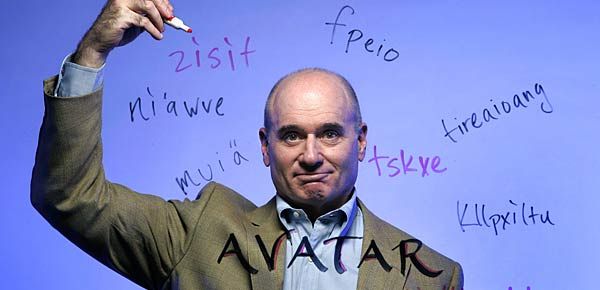
Dr. Paul Frommer, surrounded by Na'avi words he created for Avatar. Photo ©2009 Los Angeles Times.
The Language
Not satisfied with merely creating an otherworldly planet and its native beings from scratch, James Cameron set about equipping the Na’avi humanoid tribe with a language of their own. Audiences will be delighted in the authenticity—all communication on Pandora is shown through subtitles befitting a foreign film. Ever the mindful scientist, Cameron hired USC professor and linguist Dr. Paul Frommer to engineer the dialect from scratch, resulting in a respectable, self-sufficient vocabulary of about a thousand words bound by a consistent sound system, grammar, orthography, and syntax. In an extensive interview with Vanity Fair, Dr. Frommer says that Cameron approached him as far back as 2005, when Avatar was going by a code name of Project 880. As with every other aspect of this film, Cameron’s genius micromanagement provided Dr. Frommer with the basics of the sound and structure he was looking for. “I didn’t start from absolute ground zero,” said Frommer, “Because James Cameron had come up with, in the early script, maybe 30 words. Most of them were character names, but there were a couple of names of animals. So at that point I had a sense of some of the sounds that he had in his ear and it reminded me a little bit of some Polynesian languages.”
In addition to painstakingly working on the syntax for over five years, which he compiled into a pamphlet entitled Speak Na’avi, Dr. Frommer worked closely on-set with Avatar actors to ensure proper pronunciation and phonetic differences between native Na’avi speakers, and their human avatar contrasts. Beyond the film, Dr. Frommer is not done developing Na’avi, in the hopes that it might take off like Klingon did post-Star Trek. “I’m still working and I hope that the language will have a life of its own,” the professor said in an interview with the Los Angeles Times. “For one thing, I’m hoping there will be prequels and sequels to the film, which means more language will be needed. I spent three weeks in May, too, working on the [Avatar] video game for Ubisoft, which is the name of a French company.” (The Hollywood Reporter recently posted a terrific interactive preview of the video game.)
The Science
A technically-adept filmmaker such as James Cameron could have been satisfied with simply allowing his 3D team to virtualize Pandora, especially since most of the world is synthesized from scratch. Instead, Cameron, himself an accomplished diver and the brother of an engineer, painstakingly, some would say obsessively, set about populating the moon with flora and fauna using rigorous scientific methodology. He enlisted the help of UC Riverside botanist Jodie Holt, who became an expert on Pandora’s vegetation and mentored Sigourney Weaver in portraying a botanist in the film. Each leaf, plant, creature, and weed was given an original Na’avi name, a Latin taxonomy, a biological description, population and occurrence, ecology and ethnobotany. Click here to watch a brief interview with Dr. Holt about her role in assembling the biological vision behind Padora’s ecosystem.
Incidentally, all of the information I have written about above and more is being compiled by the film’s writers, producers and directors into a 350-page tome called Pandorapedia, to be made available later this winter. Until then, for curious fans and film devotees looking to gain insight into the artistic development process of Avatar, ScriptPhD.com recommends the stunning design book The Art of Avatar, reviewed below.
Cinema, Meet Art + Design
The Art of Avatar ©2009 20th Century Fox and ABRAMS Books. All rights reserved.
While planning and technology were essential nuts and bolts of its cinematic architecture, they alone do not constitute the blueprint or heart and soul of a film such as Avatar, especially considering the ambitious multi-thematic plots and visual realm. Like any innovative, transformative concept or endeavor, Avatar began and ended with the simple sketch. In a gorgeous, 120 full-color illustration rich companion volume, The Art of Avatar, written by Lisa Fitzpatrick, James Cameron and Peter Jackson, provides a fully transparent visual documentation of the first phases of the development and conceptualization of Avatar. The book’s 200+ works of art include compositions by renowned film artists (Rob Stromberg, Wayne Barlowe, Ryan Church, Ben Proctor and Cameron himself), descriptive script excerpts, commentary and a guide to each component’s realization process. As Fitzpatrick notes in the book’s copy, “it is the artist behind the technology that makes the images of this book, and ultimately the movie, so remarkable.” Having seen both (review here), ScriptPhD.com wholeheartedly agrees.
Suspension of disbelief. The cornerstone of any creative compact between a film and its audience. A compulsory foundation for escaping into imagined worlds and embracing its characters and adventures. Notwithstanding this axiom, Avatar still represents a giant leap forward in the world of filmmaking, according to Peter Jackson, Oscar-winning visionary behind The Lord of the Rings and recently District 9. “Every once in a while, we will see a movie that transcends cultural barriers, genre and taste—a film that lives on in the minds of the audience, years after the fact, a film with a story, characters and dialogue so memorable that it creates its own mythology,” Jackson notes in his foreword to The Art of Avatar. A project of such magnitude can initially seem insurmountable. Executive Producer Jon Landau said he felt like a NASA engineer in 1961 when President Kennedy announced we were heading for the moon—only the moon in question was Pandora.
Much of the initial design was jump-started by Cameron, himself a talented illustrator and meticulously descriptive screenwriter. His own sketches included largely preserved concepts of Na’avi clothing and signature physical appeararance, including a complete design of the heroine Neytiri’s painted face. The humans’ habitat the Venture Star included an 11-page document on how the ship functioned, with physics and engineering details such as light-speed calculations, pod dynamics, engine thermodynamics and architectural plans. Cameron’s Avatar script treatment—a plot and content synopsis—included visual primers such as glowing phantasmagorical forest, purple moss [that] reacts to pressure, rings of green light, dreamlike, surreal beauty that allowed artists to create accurate renderings of Pandora’s biosphere (see below picture).
Pandora's breathtaking panorama, observed by the avatar Jake and his native love interest Neytiri.
Content in The Art of Avatar is smartly divided into categories, including transport, science, gadgetry, and biology. Transport and gadgets, including the Valkyrie shuttle and the Samson untilitarian vehicle, are designed with layouts and specificities worthy of industry standards. Particularly impressive to The ScriptPhD were the details and accuracy of early renderings of the home base biolab, clearly conceived by a man with a profound respect for science. Illustrations of labs are laid out to look like actual labs, with incredible attention to the link unit allowing the humans to transform into their avatars and the incubator tubes housing avatars, by far the most challenging prop for Weta Digital to produce. As an example, the Armored Mobility Platorm (AMP) suit used by military to safely roam around Pandora was designed by TyRuben Ellingson to be functional and accessible (good viewing capacity, easy maneuvering, flexible joints, rearview mirrors). Pictured below is just one of a multi-page design book for the AMP suit alone!
Engineering design of the AMP military suit.
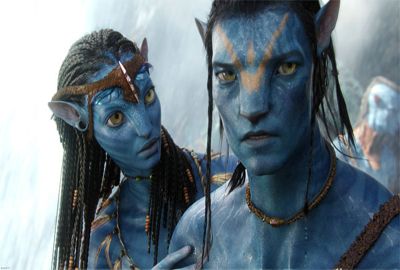
The Na'avi princess Neytiri with the avatar Jake. Cameron describes her in the script: "She watches, only her eyes are moving. She is lithe as a cat, with a long neck, muscular shoulders, and nubile breasts. And she is devastatingly beautiful-for a girl with a tail." ©2009 20th Century Fox.
Biology illustrations are largely split categorically by flaura/fauna and creatures. Pandora’s many unique forests, the Home Tree and Floating Mountain key to the film’s plot, the illuminated foliage, and bioluminescent Fan Lizards and Woodsprites—original Cameron creations—each get individual renderings. In several pull-out pages, the creative process is gradual. Neytiri, for example, started as a pencil sketch, evolved into a clay figurine, then 3D artwork, and finally a screen version. Most interesting to note was the process of creating the original creatures of Avatar. The most critical and symbolic of these was the Banshee, a heroic creature that enjoys a lot of screentime in the film. It is meant to be a metaphor for the eagle, and, as a transport vehicle for the Na’avi, to represent them as a flying culture. Take a look at the transition between an early automotive biomechanical concept sketch by designer Wayne Barlowes and final color digital drawings.
Early concept drawing of the Banshee bird, meant to employ biomechanical form and function.
The final color illustration.
In an exclusive epilogue, James Cameron confesses that he feverishly wrote Avatar in 1995 over the span of just three weeks, fueled largely by his own imagination, every piece of fantasy art ever created, and his rigorous, extensive experience under the ocean. While certain things were specific to Cameron’s preferences—namely the Thanator and Viper wolf drawn by himself—all others were achieved through a sometimes turbulent, always rewarding collaborative process with a talented team of artists, designers, scientists and technologists. “The goal [of the design] became to mix the familiar and the alien in a
unique way,” Cameron states. “To serve the metaphor and create a sense of familiarity for the audience, but to always be alien in the specifics.”
Lucky, lucky audience.
Avatar Trailer:
The Art of Avatar was released November 30, 2009. Avatar wemt into wide release in IMAX and theaters nationwide on December 15, 2009.
~*ScriptPhD*~
*****************
ScriptPhD.com covers science and technology in entertainment, media and advertising. Hire our consulting company for creative content development.
Subscribe to free email notifications of new posts on our home page.
]]>
Image ©Matt Groening, all rights reserved.
So the ghosts and goblins of Halloween have passed, you already watched Paranormal Activity, and yet, you’re still in the mood for some scary, sci-fi goodness. Rest assured, because this weekend, two new movies, The Fourth Kind and The Box, will frighten the pants off of you. (Unfortunately, only one is meant to do so intentionally.) The Fourth Kind explores alien abductions through the story of an actual Alaska case study, while The Box is a psychological thriller that centers around the morality of a life-changing decision. ScriptPhD.com reviews of both films, under the “continue reading” jump. Leftover ScriptPhD Halloween candy goes to those that guess the cultural work invoked by the spoof in the picture on the right.
Review: The Fourth Kind
ScriptPhD.com Grade: B+
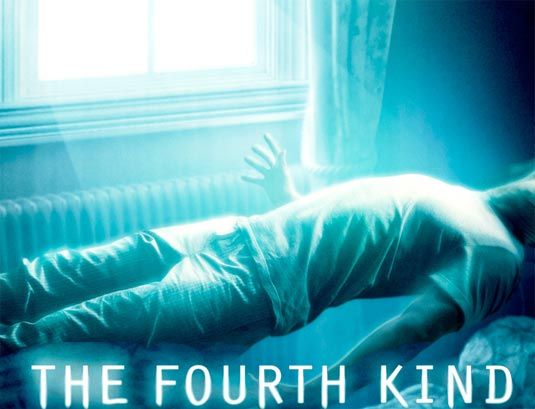
The Fourth Kind poster image ©2009 Universal Pictures, all rights reserved.
Television and cinema has a long history of preoccupation with alien encounters and abductions. From the sci-fi classic V, recently re-launched as a remake, to the recent hit The X-Files, from Steven Spielberg’s Close Encounters of the Third Kind to current hit Paranormal Activity, audiences have been treated to a panoply of abduction theories and scenarios, with distant alien life forms ranging from the curiously benevolent to the violently malevolent. But no movie has dared to infuse a level of sophisticated reality to its storytelling… until now. The Fourth Kind, part movie, part re-enactment, and part documentary, chronicles a curious case study in the small town of Nome, Alaska, involving a cluster of paranormal events from January 1st – January 9th of 2004 affecting a subset of the town’s population. Inexplicable disappearances, clusters of patients suffering from insomnia, and shared visions of owls taking on the form of something far more scary, more sinister. All of these events were studied and recorded by sleep psychologist Dr. Abigail Tyler (portrayed in the film by Milla Jovovich), who herself had a burden to bear over the mysterious sudden death of her husband and co-researcher. What he unearthed was a series of encounters and abductions with alien life forms affecting about 300 local patients, leaving some psychologically scarred and others violent or suicidal. When her own child goes missing in the midst of her probes, Dr. Tyler undergoes hypnosis, and a shocking journey of revelations about her own role in this saga.
The Fourth Kind is titled after the nomenclature system of astronomer and UFO researcher J. Allen Hynek, which classifies levels of interaction with artificial intelligence, from encounters of the first kind, a UFO sighting, to the ninth and ultimate kind, an alien species revelation to humans. The question that audiences will be asking, of course, is: is the movie indeed real? My take? It’s a viral marketing campaign by Warner Brothers akin to The Blair Witch Project, and an effective one at that. There was indeed a spate of disappearances in Nome in 2004, but a 2006 FBI memo attributed most of the 24 deaths to the deadly combination of alcohol and a harsh winter. Google searches for an Abigail Tyler fail to bring up any substantial websites (those that reference her have been taken down since the movie’s premiere), and neither the Alaska psychiatric licensing board nor the city of Nome has records of an Abigail Tyler. Nevertheless, writer/director Olatunde Osunsanmi pulls no punches in the reality department. Re-enactments of patient sessions are interspersed and sometimes superimposed with “actual footage” with the real Dr. Tyler. Side-by-side panels of the archival footage are supplemented with 911 calls of frightened patients and threaded with a taped interview between Dr. Tyler that recounts the events depicted in the film.
Ultimately, whether the film is an elaborate studio ploy is irrelevant, because what needs to be real is—the terror. While not quite matching the horrifying verisimilitude captured in simplistic perfection by its current rival Paranormal Activity, The Fourth Kind derives audience reaction if by the power of mental suggestion. It could happen to you. It doesn’t matter if it’s a marketing ploy, because while you are sitting in your chair, the very idea of the possibility will make the hairs on the back of your neck stand up (The ScriptPhD will sheepishly admit to having watched half the film between her fingers). With the exception of some fine scenery chewing by the skeptical local sheriff (Will Patton), the acting in the movie is first-rate. A clever and well-done editing effort mixes just the right combination of film and documentary footage to infuse a sense of building panic towards the truly surprising denouement—done with an understated, less-is-more camera pan-out. And let’s face it folks, at the end of the day, people levitating off of beds, contorted faces of agony, non-human warbled alien speech and creepy, fuzzy, black and white recordings are always sure to make the popcorn fly.
For an in-depth discussion of alien abductions, please view this featurette from Universal Pictures in which paranormal writer/researcher Marie D. Jones discusses encounters of the fourth kind and learn why she says experts believe that these similar experiences can’t just be thought of as coincidence.
The Fourth Kind opened on Friday, November 5, 2009 in theatres nationwide
View trailer:
Review: The Box
ScriptPhD.com Grade: C-
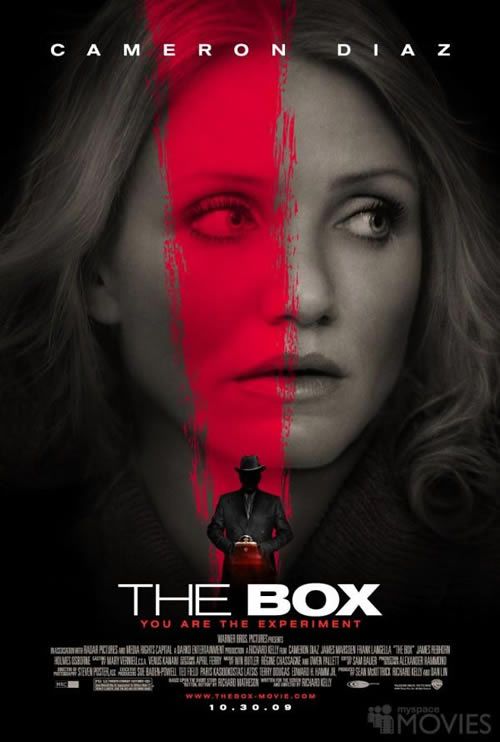
The Box image ©2009 Warner Brothers Films.
Count The ScriptPhD among those excited to see another film written and directed by Richard Kelly, the brilliant mastermind behind Donnie Darko, which remains one of my favorite cult classics of the past decade. Unfortunately for the viewing audience, Mr. Kelly’s return comes in the form of The Box, a disasterous horror film/morality tale/tragedy/unwitting comedy from Universal Pictures starring Cameron Diaz. Norma Lewis is a private school teacher in 1976 Arlington, VA. Her husband, Arthur (James Marsden), is a NASA engineer working on the Viking Mission, NASA’s first robotic landing on Mars (check out the official NASA 30th anniversary website). By all external accounts, they are living the idyllic suburban life. Though you wouldn’t know from their enormous house and Arthur’s Roadster, the Lewises are beset by financial difficulties. It is at this moment that a box shows up at their door. Accompanying it is a mysterious stranger named Arlington Steward (Frank Langella), who makes Norma an offer. If she presses the button, a stranger unfamiliar to her will die, but she will receive a million dollars, no questions asked. After engaging in some perfunctory skepticism and wrangling, the Lewises push the button. But Steward is no ordinary messenger. He is Patient X, a former NASA astronaut hit by lightning, who was reborn with paranormal activities, including arrest of cellular degeneration. The consequences of pushing the button lead into a metaphysical exploration of God, punishment for Earthly sins, and the use of science and technology to manipulate our species’ proclivity towards altruism for the greater good of the species.
The Box is an adaptation of the terrific short story Button, Button by Richard Matheson. Back in 2008, SciFiDimensions.com wondered “how the twelve pages of it will translate into a full length feature film… The film version is, in all likelihood, using the premise of the story for something much bigger, and probably much less satisfying.” Oh, how prescient they were! Kelly inflates this compact, satisfying short story with plot twists, character backgrounds, the mysticism of human morality, and the kitchen sink, all while losing its identity in the process. The obtrusive staccato violin score seems to indicate it’s a horror film, the thematic plot a morality tale, the faux-detective murder plot a suspense drama, while the inappropriate laughter elicited from the press corps during the screening revealed a comedy. The Box is one giant technospiritual experiment, for which Steward is an earthly steward. Those that choose money over moral impunity are recruited as “employees” of the experiment, and travel through one of three gateways to heaven or hell. Why a box as a symbol? Because, Arlington expounds, life is a box. We travel in a box to come to a home that is a box, to stare at a television that is a box in a body that is a slowly decomposing box only to be buried in the ultimate box. Oh my profoundness. If enough people would only choose to not press the button, the horrifying murders, zombie physical transformations, and recruits to hell would stop. As would this movie.
Among Arthur Lewis’s scientific artifacts is a large poster with a famous quote from the science fiction master Arthur C. Clarke: “Any sufficiently advanced technology is indistinguishable from magic.” This pretty much summarizes this movie’s attitude towards science. Norma’s crippling foot injury is ascribed to tissue necrosis by radiation from an X-ray machine left on by a doctor in the 1950s. In rare cases, skin destruction, tissue loss, and amputation do result from high-dose X-ray exposure, 2,000-3,000 rems. At typical absorption rates from medical X-rays (6 milliRems for joints and extremities), this would mean the doctor left the X-ray on for hours and hours and hours. To help her walk normally again, Arthur crafts a prosthetic in his chemical lab at work, a gesture both sweet and apparently magical. Norma is able to slip it into her shoe, and shake her limp faster than Verbal Kint in The Usual Suspects. While Kelly was clearly going for an atavistic throwback visually (including post-production manipulation of digital images to mimic 70s film appearance), the hokey sci-fi gadgets veer into the cartoonish and ridiculous, not the least of which is The Box itself, let alone the mystical high-tech water tanks and wind turbines that facilitate communication between Arlington Steward and “those that control the lightning”. About the only thing that the movie got right was a visual recreation of the NASA Langley facility in 1976, for which the movie recruited NASA veteran and science fiction author Gentry Lee, one of the original members of the Viking Mission team.
Despite its many shortcomings, this movie is not without some redeeming qualities. The always-bankable, marvelous Frank Langella is the cast standout. His portrayal of the mysterious Arlington Steward is understated, elegant and charming, in complete contrast to his hideous facial disfigurement. Arlington’s reactions of disappointment, fatigue and even disgust at humans’ inability to forego immorality to advance selfish desires, thus endlessly repeating the cycle of The Box, are about the only believable ones in the movie. Like the short story, the thematic exploration of psychological terror, guilt and decision-making are interesting. Do you press a button that will kill someone you don’t know but offer you financial freedom? How well do any of us know one another? Had some of the superfluous plot “twists” been minimized, The Box could have delved more into individual character development and questions of the power of technological development, but alas. “The Box isn’t big on violence or gore; it’s more of a thriller in the retro style of the movies I grew up on as a kid, and that kept me on the edge of my seat,” says Kelly. Pity. The only thing that kept me on the edge of my seat was wondering when the agony would end.
The Box opened on Friday, November 6th, 2009 in theatres nationwide
View trailer:
~*ScriptPhD*~
*****************
ScriptPhD.com covers science and technology in entertainment, media and pop culture. Follow us on Twitter and our Facebook fan page. Subscribe to free email notifications of new posts on our home page.

Our Fall Science Television preview concludes with our last installment. ScriptPhD.com give you a sneak peek of the conclusion of Warehouse 13, the hit reality show Destination Truth, and new series V and the delectable, highly-recommended ScriptPhD.com pick for best new fall show, Stargate Universe. I sincerely hope that our three-part guide to some (though not all) of the vast and rising science and technology content on television was a helpful guide and provided you a variety of options from shows returning and launching as you embark on your Fall TV seasons. Wishing you all full TiVos and busy remotes!

V image ©2009 ABC, all rights reserved
V
Season premiere on November 3rd on ABC.
Where were you when JFK was assassinated? Where were you on 9/11? Where were you this morning? These ominous questions, flashed for the audience at the beginning of the V pilot, are intended to convey: something important is going to happen. Using an excruciatingly suspenseful build-up to introduce the main characters, a series of shaking events leads to a spaceship hovering over New York City and, as it happens 29 others around the world. [Those of you who enjoyed District 9 are not hallucinating at the V poster--you will note some quite obvious parallels in this show.] There is some spectacular imagery and special effects in play as a blinding light reveals a surprisingly beautiful human face–Anna (Morena Baccarin), the leader of a stranded people, in search of sustenance and replenishment, all in exchange for their advanced medicine and technology. Everything seems peaceful, idyllic and perfect. Seems.
Right away, amidst an outpouring of affection and goodwill, incongruities pop up. The “V”‘s (visitors) are curing diseases, giving rides in spaceships, and boosting local economies. But the ambassador Anna will only give a filtered, staged interview about her people to an ambitious TV reporter (a delightfully smarmy Scott Wolf). The V Ambassador Program to spread their culture and beliefs seems more akin to a cult–one that snares the son (Logan Huffman) of FBI Agent Erica Evans (Lost alum Elizabeth Mitchell). All this devotion to the V’s arouses the suspicion of Father Jack Landry (Joel Gretsch) despite people flocking to churches. He is warned that the V’s are really out to obliterate humanity and are not what they seem. An unrelated piece of evidence–that terrorist chatter is up since the arrival of the V’s–yields a secret New York City terrorist cell with C4 explosives.
The two plots fuse together in an ending that is so shocking and central to the extended plot of the show, that ABC asked critics not to reveal any of it. And really, why would we want to ruin your fun? Suffice it to say that the “reveal” of the global spaceships was Part I of an elaborate deleterious plan already set in motion decades ago. Global figures, senators, politicians, everyday people are not who you think they are. The infiltrators will surprise you. And some of their actions will surprise you even more. V, armed with an excellent ensemble cast and terrific writing, explores some salient, important themes; the destructive power of unchecked devotion, and the need of human beings to believe in something in the face of daunting adversity, but at what cost? The consequences are dire, the foes fiercely armed, and the ultimate war will be launched. Let’s hope that what was a thoroughly satisfying, intriguing pilot is developed into a cogent, well thought-out piece of science fiction.
While not as tightly composed as the wonderful FlashForward, V still has some fine acting, suspense, some genuine surprises, and a mysterious story arc that should keep me watching at least through the first season. A definite ScriptPhD.com sci-fi pick.

Warehouse 13 is ©NBC Universal, all rights reserved
WAREHOUSE 13
Season finale airs on September 22, 2009 at 9 PM on SyFy.
One of this summer’s unexpected (and inexplicable) hits, breaking out as one of cable’s top 10 programs, was SyFy’s original procedural about a team of United States secret service agents working in the government’s secret Warehouse 13, a storage unit in the middle of South Dakota, that houses supernatural objects, relics and artifacts from history. Fallen agent James MacPherson (how much do we love Roger Rees? So much!), an archnemesis of the team throughout the first season, reappears in the season finale, properly entitled “MacPherson”, brings this conflict to its climax and conclusion (or is it?)
The ScriptPhD has screened the season finale, and can verify certain questions are answered while others are raised. MacPherson, having absconded with the fire-resistant phoenix medallion, along with other artifacts, plans to sell them for nefarious purposes. In the hunt to retrieve them (and him), it is revealed that computer whiz Claudia Donovan knows James, and may have even had help from him to hack into the Warehouse computer system. Just as Agents Lattimer and Bering bring him in to be permanently bronzed (seriously, I said bronzed), something unexpected happens, and MacPherson receives help from the person you least suspect. Someone will have possibly perished, someone is a traitor in the midst (and it’s the person you least suspect), and a whole new season’s worth of mystery is set up in the last five minutes.

Destination Truth image ©NBC Universal, all rights reserved
DESTINATION TRUTH
Airs Wednesday nights at 9 PM on SyFy
For those of you looking to spice up your science reality beyond the occasional National Geographic special, you might consider SyFy’s popular reality hit Destination Truth. Like its network sibling Ghost Hunters, the show, now in its third season, focuses on diffusing the occult and unexplained through the scope of research and the scientific method. Think Survivor meets MacGyver. With a training in both dramatic arts and archaeology, host Josh Gates uses acting chops and bona fide science credentials to look into the world’s most intriguing unexplained mysteries… with flair. At times cheesy [seriously, throw anyone into a pitch-black environment with a night-vision camera and it will engender spookiness] and other times truly interesting [an exploration into the unexplained paranormal hauntings of the Romanian Hoia Baciu Forest ends up with some unexpected results], Truth Hunters still manages to entertain while informing. Josh and his team still examine the evidence using all the technological tools in their arsenal–soil and water samples, thermal imaging, electromagnetic imaging, etc–to come to a science-based conclusion, and only makes definitive statements if the trail of evidence allows it. That, and did we mention the scenery is gorgeous!
This season promises many exciting adventures, with Josh traveling the far corners of the world, including the Himalayan kingdom Bhutan, the heart of Chernobyl, home of the worst nuclear accident in history, an overnight stay in King Tut’s tomb and dives in ancient Caribbean caves.
And finally, I’ve saved the best for last…
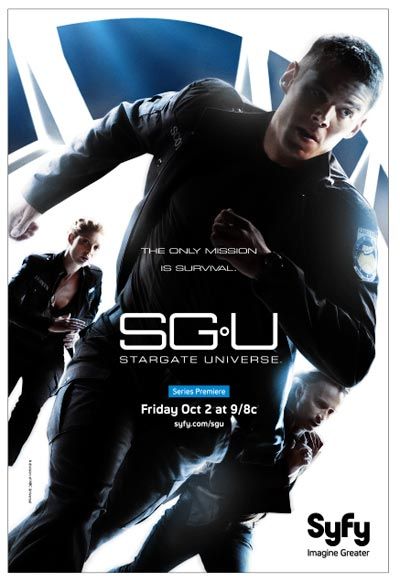
Stargate Universe image ©NBC Universal, all rights reserved.
STARGATE UNIVERSE
Series premiere airs on October 2nd at 9 PM on SyFy.
Imitation, while always the sincerest form of flattery, can sometimes be a double-edged sword. And in the world of television, especially when emulating a Peabody award-winning series such as Battlestar Galactica, it’s a huge risk. From the first shots of austere, dilapidated oblong tube-like hallways of a base ship, it’s obvious that new series Stargate Universe is channeling the spirit of its just-concluded post-apocalyptic cousin. Like in Battlestar, a group of humans fight for their survival on a displaced vessel far from home under savage conditions. There are FTLs, coordinates, and ship jumping galore. There is also a deeper subtext woven into the microcosm that explores the deeper existential issues of justice, science and reason versus emotion and might, and cohesiveness across race and class. And like Battlestar, it makes for compelling, incredible television.
Eli Wallace (David Blue), an MIT dropout video game nerd, is approached by the Secret Service and informed that the secret weapons puzzle he mastered required solving an ages-old math proof. “What are you going to do, beam me up to your spaceship?” he deadpans when they attempt to enlist his help in a project. Yes, actually. Eli finds himself aboard a hyper-secret US government military mission-a hidden baseship deep in outer space. He must solve an ancient language to navigate a Stargate, a millenia-old portal allowing instant transportation anywhere in space that has been modified due wormhole dangers. Only when the base comes under attack unexpectedly, the crew aboard must jump through the Stargate unknowingly for their survival. which is where the Stargate Universe story begins. A group of soldiers, scientists, and civilians end up on an ancient ship–appropriately named the “Destiny–headed on a self-driven course millions of light years away from Earth and completely unsuited to support them.
What had started out as a high-tech mission to outer space becomes an instinctual fight to survive, subsist and get along. Serving as a primer of the weekly exploration, science and humanistic backstories that will serve as the platform of the larger story arc, one of the first episodes centers around a mission to a nearby desert planet to find chemical lye to neutralize carbon dioxide threatening the crew of the ship. A book-smart but socially stunted Dr. Nicholas Rush (Robert Carlyle) butts heads with a formerly incarcerated headstrong Master Sgt. Ronald Greer (Jamil Walker Smith) over the best course of action, while a power struggle plays out between Colonels Telford (Lou Diamond Phillips) and Young (Louis Ferreira) over who is in charge of the new ship. Backstories of the characters’ lives back on Earth, told in timely flashbacks, provide a tapestry of ghosts and demons that each is carrying with them aboard the Destiny. With action, sleek sets and high-quality CGI that combine with flawed yet likeable characters forming personal connections under impossible conditions, Stargate Universe is not only instantly-addictive, it’s easily the best new show of the fall season.
To answer a burning question many fans may have, you do not need to have familiarity with erstwhile Stargates (SG-1, Atlantis, etc) to fully enjoy the experience of Stargate Universe. All questions about how the Stargate portal works, and its role in the universe depicted in this spin-off, are addressed in the pilot. The ScriptPhD screened the first three episodes with no knowledge of the aforementioned and was able to thoroughly enjoy the series.
~*ScriptPhD*~
*****************
Follow ScriptPhD.com on Twitter and our Facebook page. Subscribe to email alerts for new posts on our home page.














